Read more of this story at Slashdot.
Ronald.phillips
Shared posts
Doctor Who's 14th Time Lord Announced for 60th-Anniversary Season
Intel Arc Alchemist Gaming Graphics Cards Availability Reportedly Delayed Till Mid-Summer, Drivers Still Problematic

Intel's much anticipated Arc Alchemist gaming graphics cards may very well be delayed into mid-Summer based on the latest information from Igor's Lab. The graphics cards are scheduled for a launch by the end of Q2 but based on various problems related to the drivers, the launch is likely delayed.
Intel's First Arc Alchemist Gaming Graphics Cards Reportedly Delayed Till Mid Summer 2022, Drivers Cited As The Cause of Delay Once Again
A few days ago, we reported the expected release timeframe of Intel's Arc Alchemist graphics cards for the gaming segment. Based on the Alchemist Xe-HPG architecture, the first Arc A-Series cards were expected to hit store shelves by the end of this quarter. In fact, Intel already announced the top, Arc Limited Edition graphics card, for launch by the end of Q2 2022. Intel has also announced the winners of its Scavenger Hunt to be the first to get their hands on the new graphics cards, even before they hit store shelves.
But as of right now, reports regarding the proper launch are looking grim. Igor Wallossek reports that based on various sources, Intel might postpone the actual availability of its gaming graphics card lineup till late Summer. This sets a time period of July 1st till August 31st. Igor also reports that AIBs are becoming quite frustrated with Intel's planning and don't know when the graphics cards are going to actually launch.
The reason, once again, is cited to be the drivers. You might remember our previous report that also cited how drivers are the main cause of the delay and Intel wants to sort out all the issues prior to releasing their cards. That's one reason why Intel has done a limited launch of its first Arc A-series products in the Asian markets. The Arc A350M and Arc A370M GPUs for laptops are as of right now, only available in select Asian regions and in select laptops. The US, EU, and other major regions are yet to get access to Arc-powered laptops. With the entry-level lineup being shipped in such limited volume, one can imagine just how low-volume the high-end Arc 5 and Arc 7 series will get.
As for how this delay affects the whole lineup, the final specifications have already been set in stone so clocks and firmware are unlikely to change. But currently, the drivers are questionable at best. No one actually possesses the final drivers and the ones that they have in their hands are either to camouflage the actual performance or just avoid negative reports through the online press media.
NVIDIA and AMD are already convinced based on their findings that their current offerings are competitive enough to tackle whatever Intel brings to the table in the form of Arc Alchemist gaming graphics cards. NVIDIA's GeForce RTX 3070 Ti 16 GB's cancellation and AMD not pushing the RX 6750 XT way higher than the RTX 3070 is evidence that both GPU giants are very confident with their existing lineups. A mid to late Summer availability would also mean that the Intel lineup is going to end up super close to NVIDIA and AMD's next-gen graphics card launch which are also expected around Q4 2022.
Furthermore, all of these delays and driver issues don't bode well for Intel's first graphics launch. Plus, if this continues, then Intel could lose potential board partners which would affect the roll-out of their Arc graphics cards further. Overall, this isn't looking good at all but hopefully, Intel can put forward a better launch timeframe at its upcoming 'VISION' event followed by more detailed specs and pricing disclosures at Computex 2022 at the end of this month.
Intel Arc A-Series Desktop Graphics Card Lineup 'Rumored':
| Graphics Card Variant | GPU Variant | GPU Die | Execution Units | Shading Units (Cores) | Memory Capacity | Memory Speed | Memory Bus | TGP |
|---|---|---|---|---|---|---|---|---|
| Arc A780 | Xe-HPG 512EU (TBD) | Arc ACM-G10 | 512 EUs (TBD) | 4096 (TBD) | 16 GB GDDR6 | 16 Gbps | 256-bit | ~275W |
| Arc A770 | Xe-HPG 512EU (TBD) | Arc ACM-G10 | 512 EUs (TBD) | 4096 (TBD) | 16 GB GDDR6 | 16 Gbps | 256-bit | ~250W |
| Arc A770 | Xe-HPG 512EU (TBD) | Arc ACM-G10 | 512 EUs (TBD) | 4096 (TBD) | 8 GB GDDR6 | 16 Gbps | 256-bit | ~250W |
| Arc A750 | Xe-HPG 384EU (TBD) | Arc ACM-G10 | 384 EUs (TBD) | 3072 (TBD) | 12 GB GDDR6 | 16 Gbps | 192-bit | ~200W |
| Arc A580 | Xe-HPG 256EU (TBD) | Arc ACM-G10 | 256 EUs (TBD) | 2048 (TBD) | 8 GB GDDR6 | 16 Gbps | 128-bit | ~150W |
| Arc A380 | Xe-HPG 128EU (TBD) | Arc ACM-G11 | 128 EUs (TBD) | 1024 (TBD) | 6 GB GDDR6 | 16 Gbps | 96-bit | ~100W |
| Arc A350 | Xe-HPG 96 (TBD) | Arc ACM-G11 | 96 EUs (TBD) | 768 (TBD) | 4 GB GDDR6 | 16 Gbps | 64-bit | ~75W |
| Arc A310 | Xe-HPG 64 (TBD) | Arc ACM-G11 | 64 EUs (TBD) | 512 (TBD) | 4 GB GDDR6 | 16 Gbps | 64-bit | ~50W |
The post Intel Arc Alchemist Gaming Graphics Cards Availability Reportedly Delayed Till Mid-Summer, Drivers Still Problematic by Hassan Mujtaba appeared first on Wccftech.
Eldest Souls - Free Expansion Depths of the Forgotten released
Programmers, Managers, Agile, and Failures: Software's Long Crisis
Read more of this story at Slashdot.
Doctor Strange In The Multiverse Of Madness Gives The MCU An Immediate Course-Correction After Moon Knight
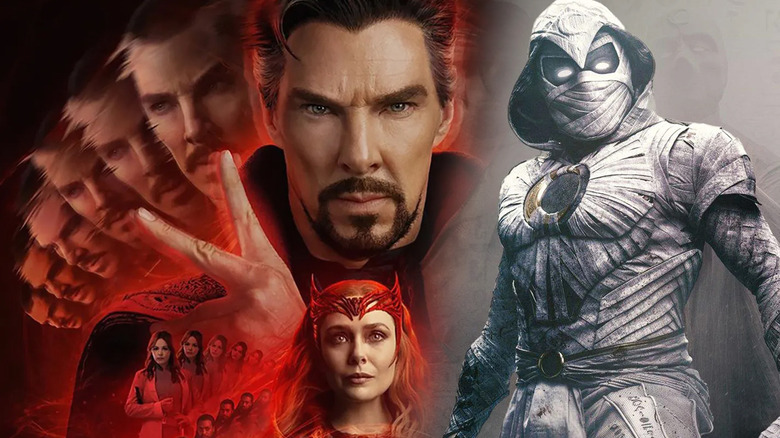
It's no coincidence, perhaps, that Marvel Studios released "Doctor Strange in the Multiverse of Madness" in the days immediately following the season finale (maybe series finale) of its Disney+ series, "Moon Knight." During Phase Four of the Marvel Cinematic Universe, we've seen some previous overlap between movies and streaming shows; however, in the case of "Black Widow" and "Spider-Man: No Way Home," they hit theaters between episode 5 and 6 of "Loki" and "Hawkeye," respectively.
"Multiverse of Madness" landed in U.S. theaters two days after the "Moon Knight" finale, and whether intentional or not, the movie acts as something of a palate cleanser, putting the longtime MCU viewer back on sure footing in a "Doctor Strange" sequel with characters we already know and care about. Is it more of the same? Yes, but that's not necessarily a bad thing when you're talking about big-screen spectacle winning out over at-home streaming boredom.
Whatever you think of "Moon Knight" (personally, I was not a fan), there's no denying that it was its own peculiar beast, somewhat disconnected from the rest of the MCU. The show spent six episodes letting us get to know a character who didn't even know himself. In the process, it introduced some bonkers new ideas to the MCU, further situating it in the realm of fantasy, as opposed to sci-fi, where it started in Phase One.
"Multiverse of Madness" features sorcery, witchcraft, and numerous gonzo elements, but it's also the continuation of more than one ongoing MCU storyline. The movie functions as much as a sequel to "WandaVision" as "Doctor Strange." It's the first MCU film to carry the "Hawkeye" billing of "A Kevin Feige production," and Feige is nothing if not savvy when it comes to crowd-pleasing and course-correcting the MCU. To that end, Stephen Strange (Benedict Cumberbatch) and Wanda Maximoff (Elizabeth Olson) help guide the audience back from the identity crisis of Marc Spector (Oscar Isaac) in "Moon Knight."
Further comparison of these two MCU titles invites discussion of specific plot points, so be forewarned: from here on out, there are potential MAJOR SPOILERS for both "Moon Knight" and "Doctor Strange in the Multiverse of Madness."
Blending In Horror
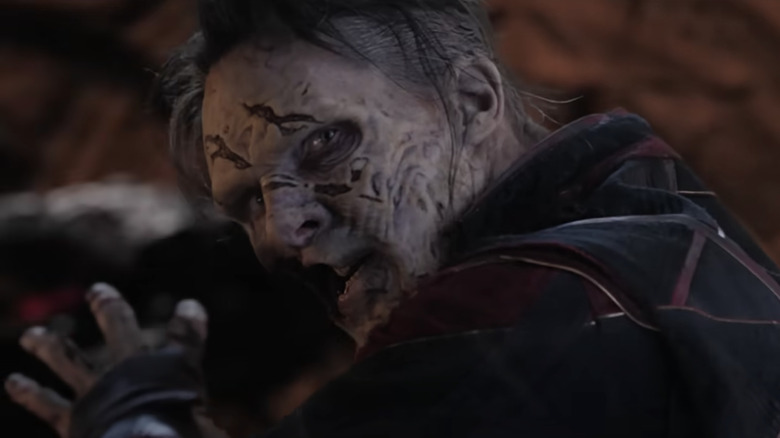
Both "Multiverse of Madness" and "Moon Knight" are genre-benders that employ directors known for their horror work, with legendary "Evil Dead" creator and "Spider-Man" alum Sam Raimi making his return to superhero fare with Doctor Strange and his weird-haired, third-eyed variants. While four episodes of "Moon Knight" were helmed by Mohamed Diab, the remaining two episodes were directed by Aaron Moorhead and Justin Benson, a duo known for horror movies like "Resolution" and "The Endless."
"Multiverse of Madness" was originally set to be helmed by Scott Derrickson, the director of the first "Doctor Strange" movie. Derrickson, too, comes from a horror background, with a filmography that includes "The Exorcism of Emily Rose," "Sinister," and the upcoming "The Black Phone." Derrickson left "Multiverse of Madness" due to creative differences, and for some genre fans, seeing the "Doctor Strange" director reunite with "Moon Knight" star Ethan Hawke on a true horror film without superheroes might be more exciting than anything the MCU has to offer.
In "Moon Knight" episode 4, which Benson and Moorehead directed, there's a scary scene where a monstrous mummy lays someone out and removes their squishy internal organs. It feels like the first true horror scene we've witnessed in the MCU, yet it also is rather jarring in the context of a show and indeed a whole shared universe that has been geared toward a PG-13 audience.
"Multiverse of Madness" has its fair share of gruesome impalements and eyeball gouging, as well, to say nothing of its zombified "Doctor Strange" and the CG souls of the damned it smuggles in from Raimi's "Drag Me to Hell." The movie subverts the fan service of cameos with fatal fights, and turns Wanda, the nascent Scarlet Witch, into a relentless, scarred, Terminator-like foe. However, even though his directorial "voice" is very much subservient to Marvel's house style here, Raimi is more adept at juggling tones. He's made a whole career out of comedy horror, whereas Benson and Moorehead's films are more like horror dramas and not as cheeky.
'Is America Okay?'
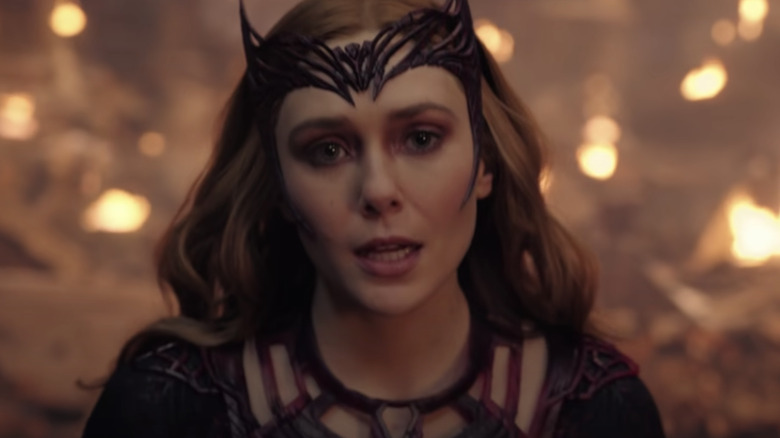
By now, the MCU and its shared-universe model carries with it the implicit understanding that each movie is not a standalone viewing experience and may even require a little homework. It has always had what Doctor Strange calls the "grand calculus" of that shared universe, now multiverse, in mind. Even if it's just a quick Google search or Wikipedia refresher, chances are, you might be left wondering about something and seeking out clarification after you watch an MCU film.
The movies don't offer recaps beforehand like the TV shows do, and when I watched "Multiverse of Madness," I was sitting next to a more casual viewer who didn't even remember who Karl Mordo (Chiwetel Ejiofor) was because the last "Doctor Strange" movie came out six years ago. Members of the fabled Illuminati — all of whom mind-map out to other Marvel movies and shows — went similarly unrecognized by my fellow theater patron (and spouse). She hadn't seen "WandaVision," which, as it turns out, isn't a prerequisite, but she could still understand Wanda's motivations, and that was enough to act as an emotional through-line.
Wanda inhabits a movie where characters escape to different dimensions, only to fall into traps. She embraces the idea that "dreams are windows into the lives of our multiversal selves." All she wants to do is be with her children, but in the end, she has to let them go and come back to her own ugly reality and face the damage she's wrought as an adult.
It's not so different from what might happened when a moviegoer, watching a superhero film that appeals to their inner child, is reminded of breaking news outside the theater like the Supreme Court overturning Roe vs. Wade, the case that set the legal precedent for a woman's right to choose. Forget the VFX-driven Raimi horror; the scariest thing in "Multiverse of Madness" is the extent to which the movie subtly comments on our own relationship, as the denizens of an infantilized geek culture, to the horrors of the real world. It gives new meaning to the name of the film's new young hero, America Chavez (Xochitl Gomez), especially when you hear that name uttered in the context of lines like, "Is America okay?"
In-Universe Vs. Outside Mythology
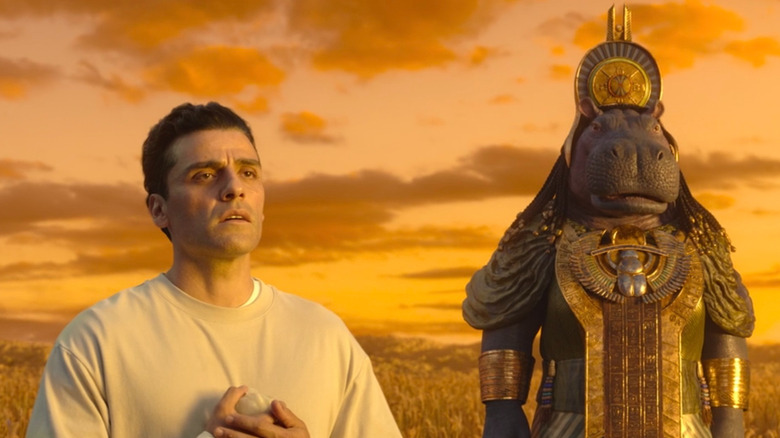
"Multiverse of Madness" is still dense and esoteric in terms of the Marvel of it all, but it's at least drawing from previous movies, shows, and Doctor Strange comics, the latter of which inform the mid-credits scene, where Charlize Theron suddenly shows up in a glam purple costume.
"Moon Knight" brought a different kind of referentiality to its narrative and was a little more unwieldy for that. The show co-opts Egyptian mythology for superhero silliness, making the existence of gods like the hippo-headed Tawaret, who isn't a comics character, canonical in the MCU (and as actual gods, not aliens mistaken for them by Vikings, per the Norse gods of "Thor"). For most viewers, the Tawaret reveal in "Moon Knight" will play one of two ways: either, it will milk shock value out of the sight of a talking hippo, or it will build on the viewer's familiarity with Egyptian mythology and the existing concept of a hippo goddess, in which case, the sight of Tawaret might seem entirely sensible.
The difference is that "Multiverse of Madness" is on-brand as Marvel. It refers to things in-universe (or, in-multiverse), whereas "Moon Knight" gives no context for certain things and presupposes academic knowledge of an outside mythology, one drawn from real Egyptian culture. The show did prep the viewer for the arrival of a "crocodile lady" with dialogue in episode 2, but the actual Ammit didn't arrive on Disney+ until four weeks later, by which point, the average viewer would most likely have forgotten about the passing mention of her crocodile-lady features.
"Moon Knight" also never explores the implications of having a Jewish superhero learn that the Egyptian gods are real. If anything, it's as loose about that aspect of Isaac's disassociated character as it was with Ethan Hawke's pronunciation of Mandarin Chinese, something even Shang-Chi himself, Simu Liu, noticed. Theoretically, Marc Spector and his family have celebrated Passover — the Jewish holiday celebrating the exodus of the Israelites from slavery in Egypt, thanks to Yahweh's (the Hebrew God) intervention and Moses' leadership. The show glosses over this, even though it unfolds over 300 minutes, where there should be more time for character-based moments.
Big-Screen Or Bust
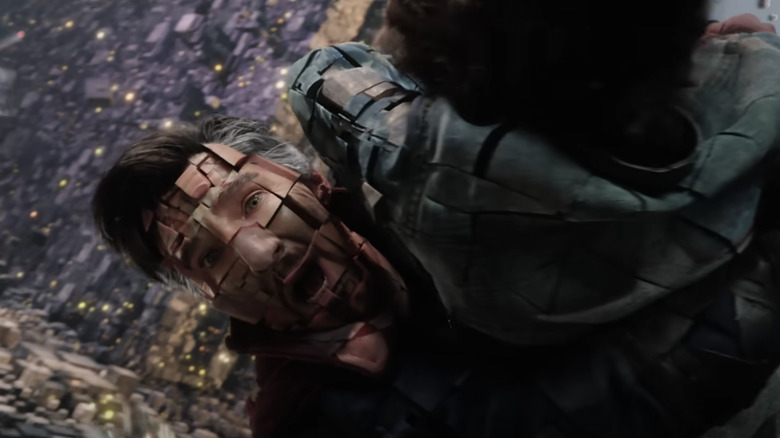
Whereas "Moon Knight" somewhat cheapens Egyptian mythology, rendering it less whitewashed but still the stuff of fantasy-action nonsense à la "Gods of Egypt," "Multiverse of Madness" knows exactly what it is: a superhero movie, drawing from Marvel history.
I would need to rewatch "WandaVision" to fully judge how well Wanda's character arc in "Multiverse of Madness" aligns with that show, but in the theater, Olson made it work. She is the best thing the movie has going for it, and it felt good catching up with her, Strange, Wong (Benedict Wong), and Christine Palmer (Rachel McAdams).
Even before "Multiverse of Madness," our viewing habits with the MCU had changed significantly during Phase Four. The advent of Disney+ in November 2019, just before the pandemic, rendered old consumer behavior, such as digitally purchasing the movies, moot, since most of the them are now available to stream at any time with a subscription.
"Multiverse of Madness" confirms that the MCU is best experienced on the big screen. It made me think of Martin Scorsese's controversial remarks a few years ago where he likened Marvel movies to "theme parks." Scorsese made a valid comparison, but I don't see theme parks as a pejorative. Sometimes, it's just fun to board a thrill ride, get lost in the spectacle, and then be done with it.
Not every ride needs to be re-ridden and not Marvel thing needs to be rewatched (or even watched at all). Years before the current fleet of official MCU shows, we had already reached a point where the market was oversaturated with shows like Netflix's "The Defenders," ABC's "Agent of S.H.I.E.L.D.," FX's "Legion," and Freeform's "Cloak & Dagger," to name just a few. It seemed impossible to keep up with every single one of them.
The simple truth of the matter is, there are too many viewing options spread across too many different streaming platforms now, and Marvel/Disney+ are just one of those options. "Doctor Strange in the Multiverse of Madness" offers a trip to the theater, where the MCU was born and will continue to thrive, regardless of what happens on the small screen in higgledy-piggledy detours like "Moon Knight."
Read this next: Every MCU Post-Credits Sequence Ranked From Worst To Best
The post Doctor Strange in the Multiverse of Madness Gives the MCU an Immediate Course-Correction After Moon Knight appeared first on /Film.
Millions of Russians are 'Tearing Holes in the Digital Iron Curtain' Using VPNs
Read more of this story at Slashdot.
Civilization VI Free Weekend
Elizabeth Olsen And Sam Raimi Need To Make More Movies Together, Immediately
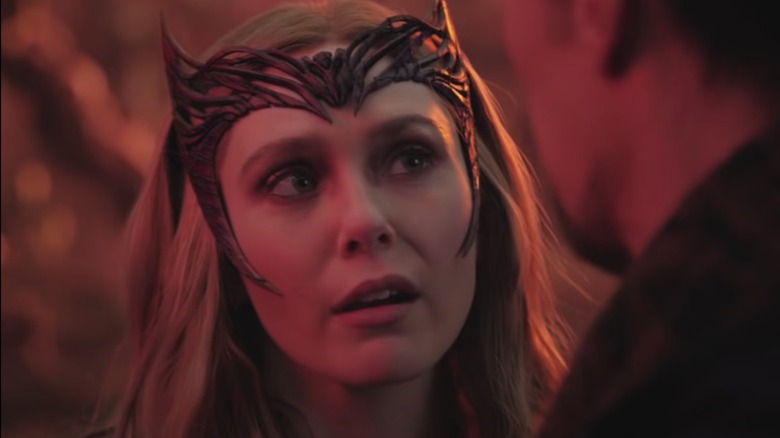
Note: this article includes detailed discussion of SPOILERS from "Doctor Strange in the Multiverse of Madness."
Elizabeth Olsen is the best bloody thing about "Doctor Strange in the Multiverse of Madness," with emphasis on the bloody. The actress, whose turn as grief-stricken Wanda Maximoff in "WandaVision" wowed audiences last year, here transforms into a scalding, single-minded source of torrential violence. Hell hath no fury like a woman broken, and the Scarlet Witch we see here — robbed of her children and manipulated by the evil influence of The Darkhold — is clearly broken. She's also a perfect, elegantly terrifying match for Raimi's stunning and pulpy horror sensibilities.
Olsen is the best part of the movie, even if Scarlet Witch isn't. The latest Marvel project hinges on a bait-and-switch that's utterly nonsense within the larger MCU canon, quickly inflating her to Big Bad status after we just started to finally understand her heart in "WandaVision." When the Wanda reveal first happened, I thought making her a full-blown villain right after humanizing her might just be an unforgivably bad twist. But then Olsen reminded us that she doesn't come to play, and she and Sam Raimi turned the movie's strange and paradoxical weakness into its greatest strength.
Olsen Goes All In As A Newly Scary Scarlet Witch
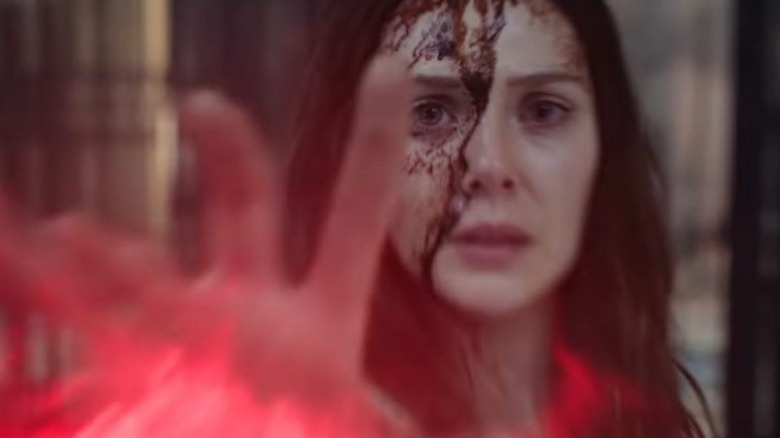
Raimi's camera clearly loves Olsen. It loves hair covered in blood and gore. It loves her face stained with tears, which it is for much of the movie. It even loves to catch her quirking her mouth in quiet confidence before exploding the head of a superhero whose entrance audiences were cheering for seconds ago. Raimi's filmmaking very occasionally falls into the house style of Marvel here, but it's the most confident and bold when he's shooting his villain. His signature flourishes make her come to freaky, engrossing life, and neither aspect would be nearly as good without the other. While the quality of the plot of "Doctor Strange and the Multiverse of Madness" will likely be debated for years to come, no one can argue against the deliciously wicked beauty of Olsen's most outright villainous sequences.
As this version of Scarlet Witch, the actress is cold and commanding, but can slip easily back into Wanda's humanity when needed. The character has long since been a lesser-appreciated Marvel utility player, but Raimi seems to see her as a star. Doctor Strange's name is in the title, but it's Scarlet Witch whose rituals the camera centers, and whose mayhem is the source of the film's best and freakiest moments. At points, Raimi lets what we're seeing veer full-tilt into horror, and whenever he does, Scarlet Witch's clawing, black-smudged clutches aren't far behind.
As a horror fan, it's hard not to look at a movie this robust and chaotic and imagine what it might look like if it were stripped down to its most interesting, cohesive, and yes, terrifying parts. I think it would look a lot like an Elizabeth Olsen led Raimi horror picture. And that thought, of course, is immediately followed by another: why doesn't that exist? Can this please exist?! Olsen has plenty of experience with the genre, as her acting career kicked off with the one-two punch of cult thriller "Martha Marcy May Marlene" and real time horror flick "Silent House." Raimi, of course, has brought us the endless blood-soaked delights of the Evil Dead franchise and "Drag Me To Hell." These are two great cinematic tastes that we now know taste great together. I for one would like to see them do this again sometime, without the clutter of any IP-driven bullet points that need to be crossed off.
Raimi Frames Olsen Like A Horror Lead
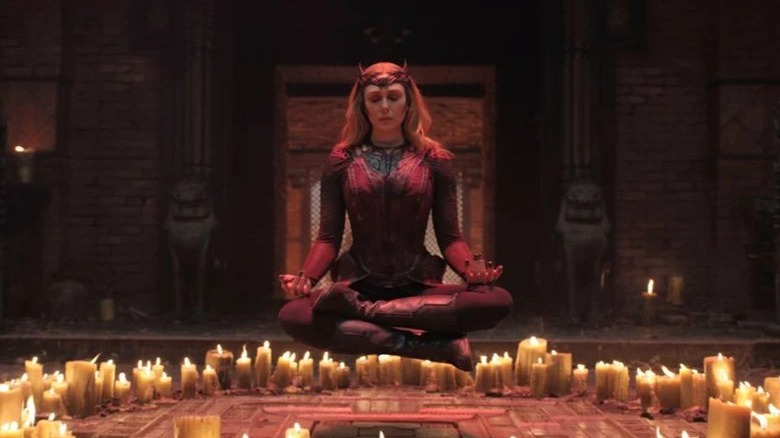
It would be inaccurate to call Olsen a scream queen, since she's clearly the one making everyone else scream this time around — but Raimi frames her like one nonetheless. He steeps the visual language of Scarlet Witch in decades of horror tradition. When an alternate universe version of Wanda is possessed by a dreamwalking Scarlet Witch, her safe suburban home suddenly becomes unnerving and strange, like so many horror movie houses before it. When the spell later breaks and Scarlet Witch is pulled back to her world, the camera flickers achingly between the two realities, and she joins a long line of women in horror left stricken by the massive emotional toll of motherhood. And when she stands on her throne at Mount Wundagore, she's yet another witchy woman whose sheer power makes her more thrilling to root for than the heroes who are meant to stop her.
"Doctor Strange in the Multiverse of Madness" is a big, bold mess of a movie, but when scraped together, its strongest parts look like a wild highlight reel for Olsen and Raimi's ability to collaborate. For her part, Olsen has expressed adoration for the filmmaker, telling Collider:
"I love Sam Raimi. He's a lovely person and I really enjoy our playfulness together of just kind of allowing ourselves to discover new things. He's a great energy and is a very specific filmmaker and loves playing with his camera. It's been fun."
There's no telling whether the beloved filmmaker will make another feature film soon: after all, it took him nine years to get back in the director's chair for this one. But if he has re-acquired a taste for the big screen, well, there's an actress we think might be perfect for his next big role.
Read this next: Every MCU Post-Credits Sequence Ranked From Worst To Best
The post Elizabeth Olsen and Sam Raimi Need to Make More Movies Together, Immediately appeared first on /Film.
Will JavaScript Containers Overtake Linux Containers?
Read more of this story at Slashdot.
Everything Everywhere All At Once Is The Superior Multiverse Of Madness Movie
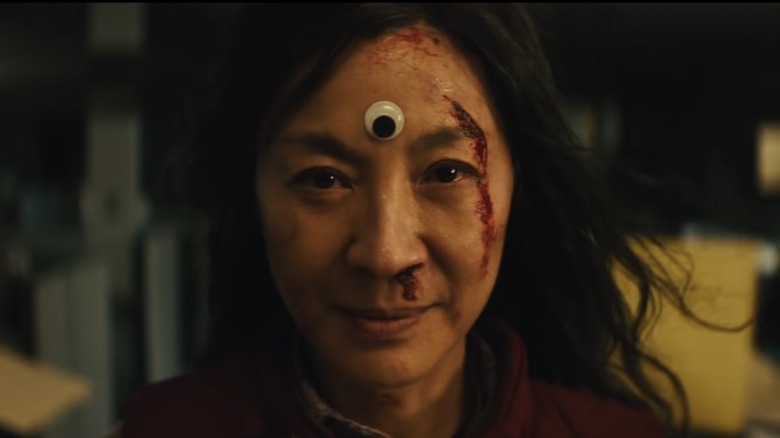
Potential spoilers for both "Everything Everywhere All At Once" and "Doctor Strange in the Multiverse of Madness" follow.
There was something slightly depressing about watching "Doctor Strange in the Multiverse of Madness" in theaters this week. There was a lot to love about this movie: Elizabeth Olson gave an amazing performance as Wanda, and because Sam Raimi was given some freedom to do his thing, we got to enjoy the first Marvel movie in a while that was genuinely scary. Wanda's murder spree was incredibly violent, feeling real in a way that sets this movie apart from the rest of the MCU. Watching Wanda chase after America Chavez (Xochitl Gomez) like the Terminator going after John Connor was a lot of fun.
However, didn't we just see a movie centered around the multiverse, one that utilized the concept's storytelling potential to a much greater degree? That movie was "Everything Everywhere All at Once," centered around a tired, overworked laundromat owner Evelyn Wang (Michelle Yeoh) who finds herself being forced to traverse the multiverse in order to defeat a villain with universe-hopping abilities. Despite their similar plots, "Everything Everywhere All at Once" is more consistently full of life and excitement. While Raimi did a great job directing the film's horror elements, everything involving the multiverse itself felt lacking.
What's So Exciting About The Multiverse, Anyway?
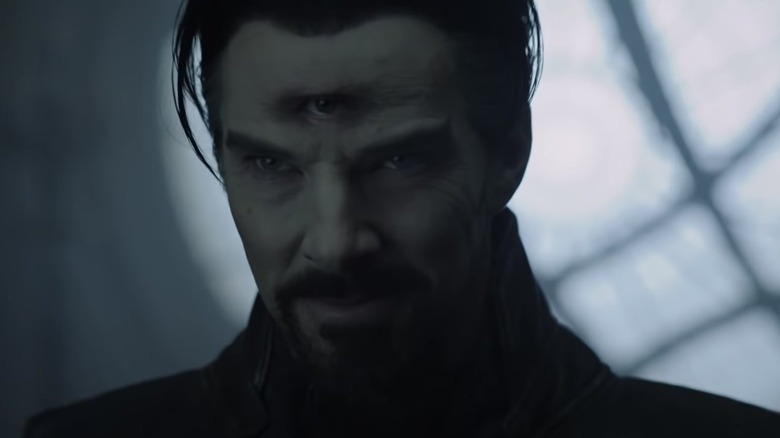
There's been a lot of interest in exploring parallel universes in the past decade of TV and film. Even "Twin Peaks: The Return" and "Mr. Robot" dabbled with the idea in their finales, letting its main character attempt to live in a universe where things seemed better. The core reason why writers and audiences seem drawn to parallel universes, one that "Everything Everywhere All At Once" understands clearly, is because it tempts us with the idea that we can escape to a world where things are easier. Evelyn gets to experience a universe where she's a martial arts protégé or a talented hibachi chef, a clear step-up from her current life as a working-class immigrant who's seemingly one mistake away from losing her laundromat. This gives her a clear character arc for the movie to center itself around: after experiencing every parallel universe in the multiverse, she realizes she'd still rather stay in the life she currently has.
"Multiverse of Madness" understands this when it comes to its villain, Wanda. She's enthralled by a parallel universe in which she has two loving kids, and will stop at nothing to experience that universe for herself. It's a good arc and, in what's standard for a multiverse story, she eventually comes to terms with the fact that her goal of escaping her current life isn't worth attaining. What about Stephen, though?
When it comes to Doctor Strange, the movie's strangely uninterested in tempting him in the way Evelyn and Wanda are tempted. Whereas Evelyn is initially established as the worst version of herself, the Doctor Strange we follow throughout the film is established to be superior to all the other Doctor Stranges in the multiverse. There's also no universe shown where he and Christine (Rachel McAdams) end up together, which seems like a missed opportunity. If you're going to let your protagonist experience multiple universes, at least one of them should be better than his own.
A Lack Of Imagination
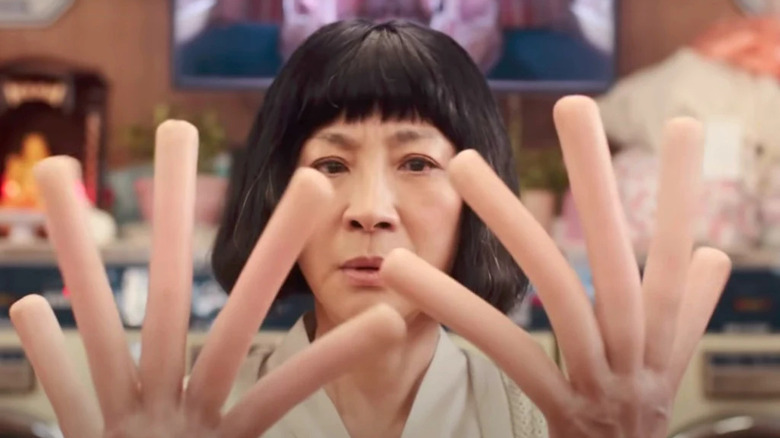
Both movies do similar tricks with the multiverse. They both feature a handful of realistic universes, one where we can basically understand how things ended up the way they did, as well as a handful of absurd universes that clearly don't make sense but make for a fun idea. "Everything Everywhere All At Once" has the "hot dogs for fingers" universe, and "Multiverse of Madness" has the "everything is paint" universe.
The difference is that the paint universe is a one-off gag, whereas the hot-dog-fingers universe is used as an opportunity to show a kinder side to one of the movie's antagonists, Deirdre (Jamie Lee Curtis), and it contributes to the core ideas of the film. "Even when we have hot dogs for hands, we learn to get good with our feet," Evelyn says at one point. It's absurd, but it also ties into the whole theme of how humans can make the best of their bad situations as long as they're open to new ideas and experiences. With the paint universe, "Multiverse of Madness" takes the "haha, so random" aspect of the hot dog universe but doesn't go any further with it.
Both movies also have a character who can hop from universe to universe: America in "Multiverse" and Joy (Stephanie Wsu) in "Everything Everywhere All At Once." Both America and Joy are characters the protagonist has disappointed multiple times in the first act of the film: an alternate Doctor Strange betrays America for the greater good in the opening scene, and Evelyn fails to support her daughter Joy's relationship with another girl in any meaningful way. The difference is that Joy is a fully fleshed-out character who has a consistently strong impact on the plot, whereas America is a plot device who spends most of the movie being escorted from place to place to avoid Wanda getting to her.
More Coherent Character Arcs
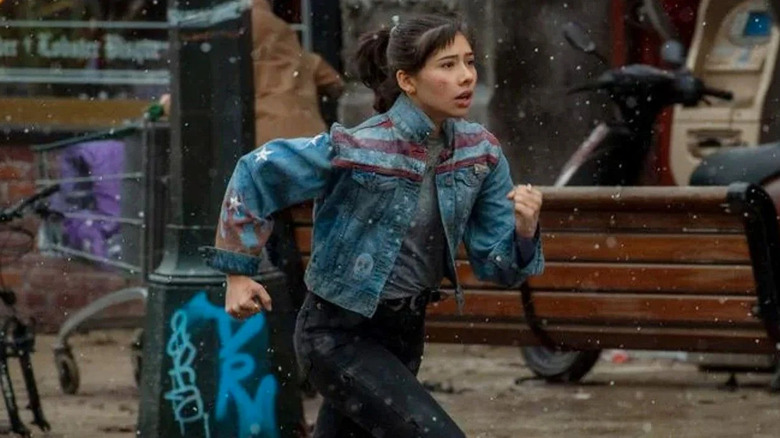
The other difference between Joy and America is that Joy's distrust of Evelyn is a lot more compelling than America's distrust of Strange. Doctor Strange has to work to prove that he won't betray America, but her distrust of him is never really Strange's fault. It was an alternate version of Strange that screws her over in the beginning, and when Strange accidentally reveals her location to the person trying to kill her, it's an accident, not some sign of a legitimate character flaw Strange needs to work on.
Evelyn, meanwhile, is genuinely not a good mom in the first third of the movie. She doesn't listen to her daughter's concerns and she's consistently inconsiderate of her feelings. She's also clearly disappointed in Joy being a lesbian, even if she claims she doesn't care. Although the film establishes early on that Evelyn wants to be able to connect with her daughter, early movie Evelyn is a coward. Instead of saying something real to Joy before she leaves the laundromat as she clearly intended, she chickens out and gives her a colder but less vulnerable talk about how Joy's gained weight. Evelyn is introduced to us as a small-minded, somewhat selfish person, and its by gaining experience and perspective that she learns to be better.
Doctor Strange has no such arc. He earns America's trust by being the person we've already known him to be. There's a bit of an arc for both characters where he chooses to trust America to use her own powers rather than take her powers away from her (thus killing her) for the greater good, but there's nothing cathartic about this resolution because there was never any real fear that he'd actually do this. Our version of Strange is never really tempted with that decision until the final scene.
Fan-Service Cameos
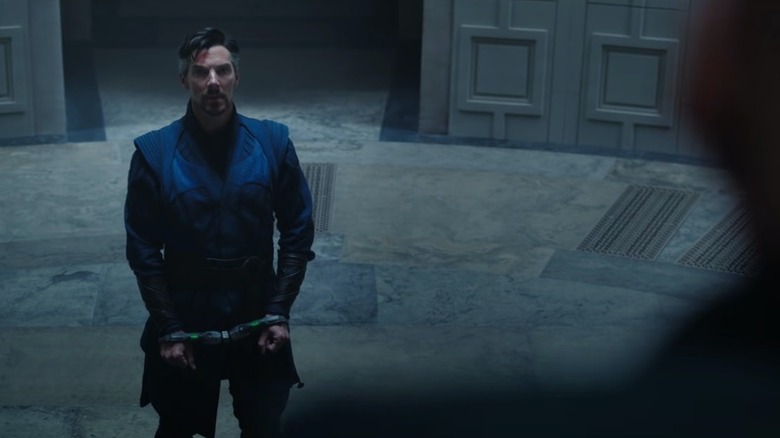
The main reason why "Multiverse of Madness" doesn't seem to take full advantage of its multiverse concept is because this is a Marvel movie. It can't just be a complete story that stands on its own, it also has to set up later movies and TV shows for other characters, and provide cool cameos for the audience to cheer at. Yes, the introduction of Hayley Atwell's Captain America and John Krasinski's Reed Richards got plenty of applause in my theater, but the whole thing felt kind of hollow to me. Professor X and Mister Incredible aren't being organically introduced into this story; they're here because Marvel got the rights back to the "X-Men" and "Fantastic Four" franchises and this is them setting the groundwork for future movies. It's an unavoidable aspect of most Marvel movies by this point, but it's still a little frustrating to watch a scene and know what's happening here is a clear studio note.
Sam Raimi may have had more freedom than previous Marvel directors in this movie, but it's nothing compared to the creative control of directors Dan Kwan and Daniel Scheinert (collectively known as "Daniels") had with "Everything Everywhere All at Once." Entirely unconcerned with setting up a sequel or contributing to a larger cinematic universe, "Everything Everywhere All At Once" is allowed to be bolder and more complete. It's allowed to introduce weird universes and stick with them throughout the movie, rather than bring them in for a simple five-second joke. With the most prominent universe in "Multiverse of Madness," its big quirk is that red lights mean go and green lights mean stop. It's kind of a funny idea, but man is it so much less imaginative than pretty much any of the universes in "Everything Everywhere All At Once."
Third Eyes And Universe-Hopping
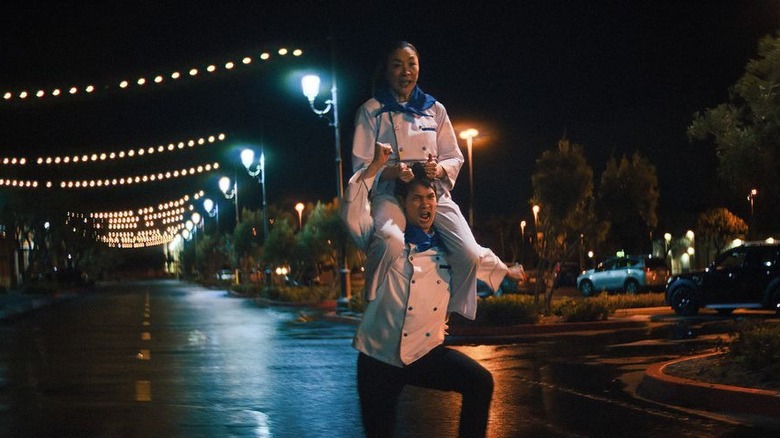
Both movies also introduce the ability for characters to control another version of themselves from a different universe. Wanda does this the most, using it not just to go on a murder rampage but to spend time with the kids she has in said alternate universe. Her two sons in this world are almost annoyingly perfect; they seem to want purely to do and say cute things for their mother, who lives alone with her kids in a conflict-free existence for our Wanda to envy. There's no hint of Vision in this universe, but Wanda seems unconcerned.
In "Everything Everywhere All At Once," there's an important point made in Evelyn's scenes in her ideal parallel universe where she's talking to her alternate husband. This perfect life, where she's rich and successful, isn't as perfect as it seems. Although Waymond (Ke Huy Quan) is also successful in this world, he mourns the life he could've had with Evelyn, telling her he would've loved to have been poor and constantly stressed out if it meant being with her. "Multiverse of Madness" plays this alternate universe for Wanda completely straight, however: her arc ends with the movie arguing that this life is in fact as perfect as she thinks it is; she just can't have it. It's not an inherently bad way to handle things, but it's less interesting than "Everything Everywhere All At Once"'s take on the same concept.
Both films also involve the protagonist sporting a third eye. With Evelyn, it's a googly eye, meant more as a symbolic representation of the character embracing empathy. The googly eye with its black pupil surrounded by white is a contrast to Joy's everything bagel, which is pitch black with a bit of white in the middle. The third eye in "Multiverse" is much more literal: it's an actual eye that offers the evil Doctor Strange actual powers. Neither of these directions is worse than the other on their own, but it's indicative of how much more"Everything Everywhere All At Once" wraps its elements around the protagonists' emotional arc, rather than using it almost entirely to further the plot.
Luckily, It's Not A Contest
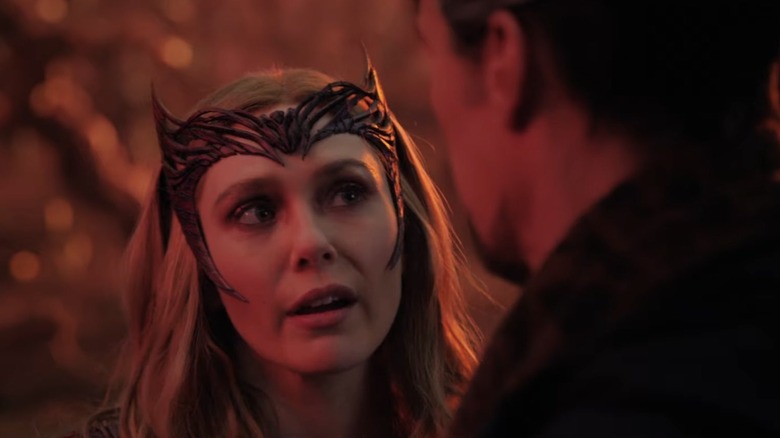
"Everything Everywhere" co-director Daniel Kwan seems to have nothing but goodwill towards "Doctor Strange in the Multiverse of Madness," having recently tweeted "Who wore it better?" referring to images of Doctor Strange and Evelyn both wearing their third eye. He followed the tweet up by saying, "I'm just nerding out because we are having our very own Deep Impact/Armageddon moment and I LOVE twin films."
It certainly does feel like a cool coincidence that two movies with such a similar premise came out within such a short period of time. Variety recently caught some flak on Twitter for seemingly attributing the success of "Everything Everywhere All at Once" primarily to audiences being excited by the multiverse concept, speculating that "ticket buyers really love the concept of a multiverse." Writer and director Ted Geoghegan's sarcastic response to the tweet sums up what most of the backlash came down to: "I, for one, definitely did not see this film because of its amazing cast, beautiful story, incredible representation, or the stunning pedigree of its talented directors. I only saw it because of [the] multiverse."
Although many fear that Hollywood's going to get the wrong idea from "Everything Everywhere All At Once"'s success, "Multiverse of Madness" shows us that Marvel, at least, understands the multiverse alone isn't enough to keep audiences engaged. Sam Raimi's take on the concept doesn't quite reach the levels of the Daniels', but there was still plenty of talent and passion behind this project, and that's what matters most. As much as I'd argue that "Everything Everywhere All At Once" is a more thought-provoking and overall compelling film, "Multiverse of Madness" is still one of the most unique movies Marvel's produced in a long time, and a promising sign for things to come.
Read this next: Horror Roles That Changed Actors Forever
The post Everything Everywhere All At Once is the Superior Multiverse of Madness Movie appeared first on /Film.
Did the Pandemic Normalize Employee-Monitoring Software?
Read more of this story at Slashdot.
70-Year-Old Cyberpunk: 'This Interview Is a Mistake'
Read more of this story at Slashdot.
Alienware's QD-OLED gaming monitor is an ultrawide marvel
Imagine everything you'd want in a gaming monitor — a bright and beautiful screen, a fast refresh rate for silky smooth graphics, HDR to really make things shine — and there's a good chance you'll find it in Alienware's 34 Curved QD-OLED monitor. It's one of the first screens to ship with Samsung's Quantum Dot OLED panels, and it's stacked with other features that'll make your Halo Infinite matches all the more satisfying. While it may seem a bit extravagant at $1,299, compared to Apple's $1,599 Studio Display it's practically a steal. (Or maybe I'm just telling myself that to justify buying this thing.)
I'll admit this up front: I'm a sucker for ultrawide (21:9) monitors. Having a ton of horizontal space makes it easy to juggle multiple apps at once, and it's far cleaner than setting up multiple displays. So when Alienware revealed that it was finally debuting an OLED ultrawide, I was sold. While OLED has solidified its place in premium TVs, it's taken a while to reach computer monitors (we only started getting OLED laptops regularly a few years ago). What makes this monitor even more intriguing is that it has all of the benefits you'd expect from OLED — deep black levels, excellent contrast and no backlight bleeding thanks to pixels that light up individually — but the addition of quantum dots means you'll continue to see vibrant colors as the screen gets brighter.
Sure, this new tech means there's another annoying display acronym to remember, but at least QD-OLED will offer some other notable upgrades. According to Samsung, it'll be able to reach up to 1,000 nits of peak brightness (like this Alienware monitor), whereas the cream of the current OLED crop reaches around 400 nits. More brightness isn't everything, especially since OLED's perfect black levels can produce some eye-blistering contrast, yet it's still a meaningful step forward as LCDs are becoming even more luminous with Mini-LED backlighting.
The Alienware QD-OLED monitor, like many 34-inch ultrawide models, features a 3,440 by 1,440 resolution. Think of it as an extra-long quad-HD screen: It's not as sharp as 4K, but it's still a huge leap ahead of 1080p. And since it doesn't have as many pixels as a 4K screen, you'll be able to play many games at its native resolution without taking out a loan for an RTX 3080 Ti. There's also support for G-SYNC Ultimate, NVIDIA's adaptive refresh rate technology which helps to reduce stuttering, as well as HDR 400 True Black. Alienware says it reaches 99.3 percent of the DCI-P3 color gamut and it's also color calibrated at the factory, both important features if you're doing any production work.
But enough specs, does this monitor actually look good in action? Yes, oh yes. My eyes watered while playing Halo Infinite's desert-based "Behemoth" map, it was almost as if I was watching the sun reflecting off pristine sand in person. (That was also a sign I needed to lower the brightness a bit.) I kept noticing new details about my Spartan's armor, thanks to the monitor's color accuracy and pitch-perfect contrast. It also took me a while to get used to playing Overwatch again, as my brain struggled to keep up with the QD-OLED's fast 175Hz refresh rate. The game reacted almost instantly, thanks to the QD-OLED monitor's 0.1ms response time.
Compared to Dell's 34-inch ultrawide gaming monitor, which I tested for several months last year, the Alienware QD-OLED looked dramatically better no matter what I was looking at. Colors popped off the screen, even when I was just scrolling through the web or watching movie trailers, and the deep curve always kept me in the center of the action. You'll have to live with vertical black bars if you want to watch typical 16x9 videos fullscreen, but personally, I'd rather have more room to play something in the corner or side of the screen. Let your TV handle movie night — ultrawide monitors are all about multitasking.
A bigger issue is the lack of support for ultrawide resolutions in some games. Elden Ring, for example, can only be played in standard widescreen resolution. (You could risk a third-party patch, but that could get you banned if you play online.) I still enjoyed the dozens of hours I spent with the game on this QD-OLED monitor, but the black bars on the sides of the screen effectively turned it into a 27-inch display. You could run the game in a window and multitask on the side, but Elden Ring is the sort of experience I'd rather devote my full attention to. At the very least, the state of ultrawide gaming is far better now than it was a few years ago. It's hard to find major titles that ignore 21:9 screens entirely, especially when it comes to shooters.
While the Alienware QD-OLED's design isn't as handsome as Apple's metallic Studio Display, it features the same sci-fi aesthetic Alienware has been pushing since 2019. The case is made of plastic, but at least it feels sturdy and smooth to the touch. There's none of the cheap flexing you'd find on budget monitors. There's a tasteful oval of LED lighting on the back of the monitor, alongside a glowing Alienware logo, but it's thankfully free of the garish bling you'd find on other gaming displays. A small fan blows hot air out of the top of the monitor, which gives it a slight hum that was easily drowned out by the sounds of my gaming rig. The Alienware monitor also offers both tilt and height adjustment, something you'd have to pay $400 more to get with the Studio Display.
When it comes to connectivity, the Alienware 34 QD-OLED includes one DisplayPort 1.4 connection (up to 175Hz), 2 HDMI 2.0 ports (up to 100Hz), and four USB 3.2 Gen 1 connections spread across the bottom and back of the display. There's also a headphone port on the bottom bottom of the monitor, and an audio line-out connection on the rear. It would have been nice to see HDMI 2.1 ports, or at the very least HDMI 2.0 connections with 120Hz support for the PlayStation 5 and Xbox Series X. Clearly, Alienware is focusing on PC gamers, but some competitors offer HDMI 2.1 to make life easier for console players.
At $1,299, you'll be paying a steep price for Alienware's QD-OLED monitor, but it’s on par with other premium ultrawide monitors. LG's 34-inch UltraGear is currently selling for $1,243, but that's an LCD screen with a slower refresh rate. Or you could just go for LG's 42-inch C2 OLED TV for $1,399, which is one of the best screens you can buy right now. (but it's probably a bit too tall for desk work). If you're looking for a similarly-sized display on a budget, Dell's (admittedly far less impressive) 34-inch ultrawide gaming monitor is down to $500.
Here's the thing: Even though Alienware's QD-OLED is a major investment, it's arguably a wise one that could last you for years. For the price of a premium display last year (and less than Apple's Studio Display!), you get next-generation OLED technology, an objectively gorgeous screen and all of the gaming upgrades you could ask for. It’s the rare gadget that makes me grin like an absolute idiot while I’m using it, surely that’s worth paying for.
Why Hackers Target Critical Infrastructure and Why It's Difficult to Upgrade Cybersecurity
In a recent 2022 Pwn2Own ethical hacking competition, two security researchers breached ICONICS Genesis64, a software designed for operators to use industrial machines, in mere seconds. In contrast, it took them three weeks to hack an iPhone way back in 2012.
Weird West Patch v1.02 Now Live

WolfEye Studios brings us the so-called Snake-In-My-Boot update for their isometric immersive sim Weird West. This update fixes a decent number of bugs, expands the game with new areas and encounters, improves the melee takedown system, overhauls throwing, and more.
Here's a trailer for this update:
And some additional details, including a few words about the next update that should be going live in June:
Giddy up for the Snake-In-My-Boot update (Patch 1.02)--now live on Steam!
This update, one of many to come, addresses a host of community feedback, fixes plenty of bugs, and introduces new features ranging from Lethal Stealth Take Down with Melee Weapons to Non-Lethal Blunt Weapons and a revamp of the Projectiles Throw system. We also improved the Posse Inventory UI and added a brand new Weapon-Scrapping Mode to make inventory management a lot easier! Finally, this update also features some new content, with a couple of brand-new travel encounters, and it also adds some new setups and new layouts to secondary locations, as part of a long-term continued effort to add variety to those secondary locations!
More details below: And if you are keen on joining the conversation for some fun chats, check out the Official Weird West Suggestion Board or join the Weird West Community Discord!
The Dev Team is now hard at work on 1.03, scheduled for mid-June, which will continue our commitment to improving the game and responding to community feedback--more details on that soon! In the meantime.. here is this patch trailer :) [...]
Inland Empire (2006) [BluRay] [1080p] [YTS.MX]

IMDB Rating: 6.8/10
Genre: Action / Drama / Fantasy / Mystery / Thriller
Size: 3.32 GB
Runtime: 3hr 0 min
After an uncomfortable, borderline disturbing visitation by a cryptic neighbour, the fading movie star, Nikki Grace, is thrilled to hear that she has just landed herself the female lead role in director Kingsley Stewart's sensational Southern melodrama called "On High in Blue Tomorrows". However, as she gradually disappears into her complex role, Nikki's character, Susan Blue, starts to emerge from the labyrinthine pathways of her unconscious, creeping into her delicate consciousness. More and more, as Nikki's dissociation becomes more aggressive, and her self-transcendent experience sets in motion a sometimes subtle, sometimes profound transformation, parallel worlds interweave, and a mysterious lost girl tuned into the TV sitcom, Rabbits (2002), begins to take shape. Is Stewart's ambitious project doomed to fail?
Become an Avatar in Ultima, the legendary RPG series by Richard Garriott
In certain gaming circles, Ultima is one of the most iconic game series out there. First released way back in 1989, the series spans nine total games, and there are even spin-offs to explore if you’ve exhausted the main campaign.
With so many games available, it can be an overwhelming experience for newcomers to Ultima. Even those that have played the series before might struggle to jump back in.
We’re going to give a brief overview of each game in the series and talk a bit about the spin-offs, as well. But, before we dive into that, we’re going to take a trip down memory lane to talk about the series as a whole and its creator, Richard Garriott.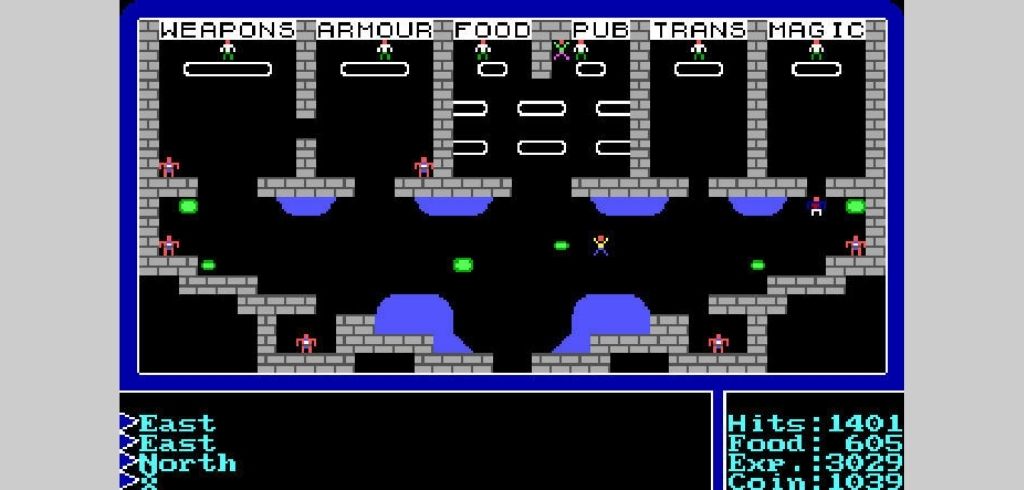
Looking back at the creation of Ultima
Ultima is well-known in the gaming community, and for good reason. The original helped define the computer role-playing genre when it was released in 1989. Later games also added features that you can still find in RPGs today.
The third game in the series, Ultima III: Exodus, was another iconic entry. This game introduced party gameplay where players controlled multiple characters. If you’ve played almost any modern RPG, you know the impact this has had on the genre as a whole.
The brainchild of Richard Garriott, the series spans the world of Britannia and takes players on what feels like an endless adventure.
Set in a fantasy world, Ultima follows the adventures of the Avatar (that’s you!). The games follow more traditional adventure tropes, with evil wizards, revenge, and classic good versus evil plot lines.
As mentioned, the series was created by Richard Garriott, who got his start making video games in 1979. Back then, he was programming them on teletype terminals, where code was stored on literal paper tape spools. At the time, he was working at ComputerLand, and game creation was just a hobby.

Then, something magical happened. One game he was working on, called Akalabeth, ended up being a huge success. It was picked up by California Pacific Computer Company. It sold over 30,000 copies.
Speaking of astronauts, Richard also made his way to space in 2008, when he was flown to the International Space Station.
Now that we’ve spent a bit of time on the origins of this iconic game franchise, let’s dive into the games!
Ultima is broken up into three different ages
The epic RPG series breaks the nine main games up into three different ages: The Age of Darkness, the Age of Enlightenment, and the Age of Armageddon.
Ultima 1-3: The Age of Darkness
The Age of Darkness is where everything starts. You play as a man from Earth who has been summoned to the fantasy world of Britannia.
Ultima 1: Summoned to a new world, you have to stop the evil wizard Mondain. But things aren’t as simple as they may seem, as Mondain holds a gem that grants him immortality.
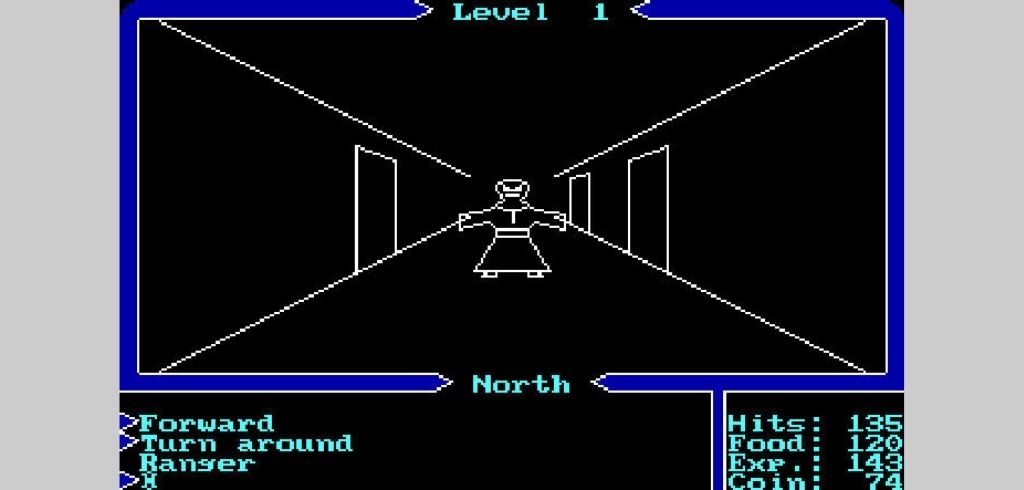
Ultima 2: The second game in the series follows the first game’s storyline. With Mondain out of the picture, you now have to stop a plot that has been drawn up to avenge the wizard’s death from the first game.
Ultima 3: Just when you thought that Mondain was completely out of the picture, a new threat is revealed that ends up being your toughest challenge yet. This game introduced the party system, which helped change RPG games as a whole.
Ultima 4-6: The Age of Enlightenment
In the Age of Enlightenment, you continue your journey, but the “good vs evil” plot is replaced by a focus on something called the Eight Virtues.
Ultima 4: Ultima 4 is a big turning point in the series. Instead of tackling an evil that has descended upon the land, you have been summoned by Lord British to act as a spiritual leader as you master the Eight Virtues.
Ultima 5: Now, as the Avatar, you return to Britannia to solve the mystery of Lord British’s disappearance and put a stop to a new evil that threatens the Eight Virtues.
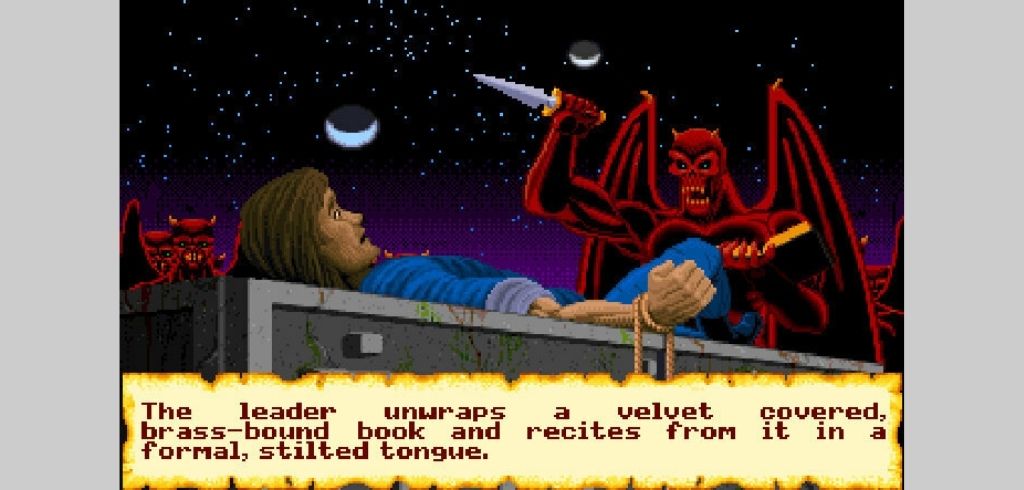
Ultima 6: A new force has surfaced and you and your companions must fight off invading Gargoyles. Not all is what it seems, however, and this game tackles themes of racism and xenophobia.
Ultima 7-9: The Age of Armageddon
The final leg of the huge series sees the introduction of the Fellowship, a group that seems good on the surface, but players quickly learn that isn’t the case.
Ultima 7 (Part 1 and 2): As the Avatar, you meet the Fellowship. You are tasked with closing an evil gate that could summon an even more evil creature. There's also an expansion that adds a tie-in story with familiar characters from past titles.
Ultima 8: This game introduces a pretty big twist. Your character has been exiled from Britannia and you have to fight your way back. It also introduces the final bad guy of the series.
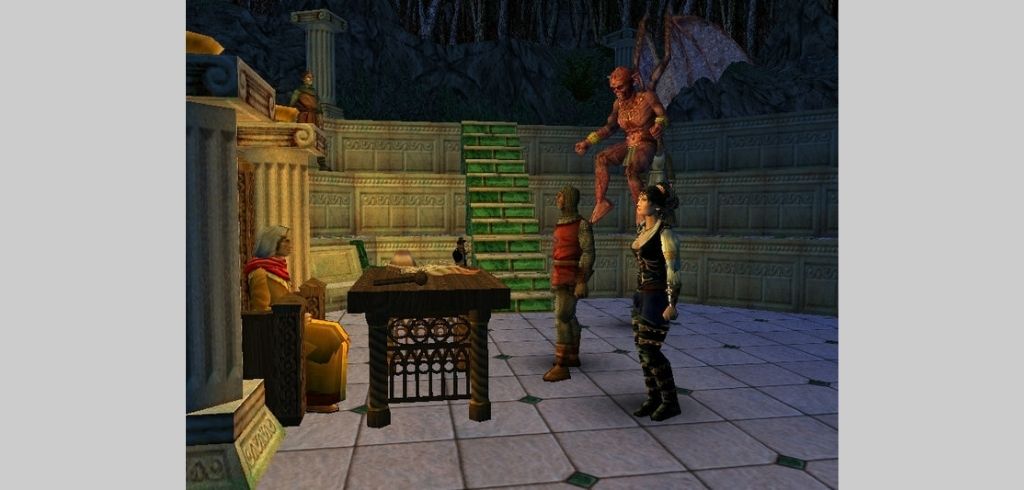
Ultima 9: The last game in the series, Ultima 9 features the conquering of Britannia and a big twist that players will have to overcome in order to cleanse the Eight Virtues and restore order.
Spin-offs in the Ultima universe
If you are able to conquer all nine (well, technically, ten!) games in the main series and still can’t get enough of the world of Ultima, then we have good news. There are a bunch of spin-off games that expand the world and story even more!
Worlds of Ultima: The Savage Empire once again has you controlling the Avatar after being transported to a new world. In this world, you’ll find many tribes that you need to unite in order to defeat the insectoid Myrmidex.
Ultima: Worlds of Adventure 2: Martian Dreams is a follow-up to The Savage Empire. But instead of being transported to an alien world, you’re transported to the Victorian Era…before going to Mars.
Still want more? Don’t worry, there’s still more Ultima to enjoy!
Ultima Underworld: The Stygian Abyss tasks players with saving the daughter of an important member of Britannia, but things are never quite that straightforward, are they?
Ultima Underworld II: Labyrinth of Worlds is the second game in this spin-off series. It takes place during the Ultima VII storyline and expands the story even more.
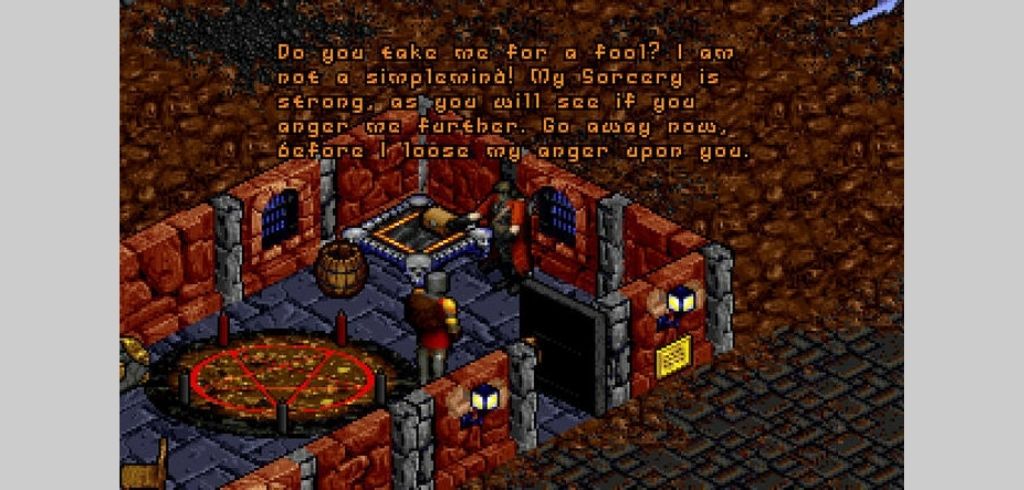
Ultima Online
Finally, we wanted to take a moment to talk about Ultima Online. Released back in 1997, it has had eight different expansion packs and lets players live in the world of Ultima. It featured both PvE and PvP content and introduced new features and mechanics to the series.
Surprisingly, it wasn’t expected to be a huge hit. But it proved many critics wrong, and even today, you can jump into the MMO world based in the Ultima universe.
At its peak, the game had 250,000 subscribers and it ended up winning a bunch of awards. It was the first inductee into the Game Developers Choice Online Awards Hall of Fame. TIME named Ultima Online one of the "100 best video games of all time."
Where to buy the Ultima series?
If you are ready to sink your teeth into the Ultima series for the first time, or simply want to revisit this renowned classic, you’re in luck.
You can snag Ultima 1+2+3, Ultima 4+5+6, Ultima 7 Complete Edition, Ultima 8 Gold Edition, and Ultima 9 directly from GOG. Many of these bundles also include extra add-ons, so there’s even more to enjoy.
Once you complete that epic saga of gaming goodness, make sure to check out Ultima Underworld 1+2, as well as The Savage Empire and Martian Dreams!
Good luck out there on your journey to become the ultimate Avatar!
What do you think? Any fond memories of Ultima or do you plan on checking it out for the first time? Let us know down in the comments!
ELEX II - Review @ World of Elex
Citizen Sleeper - Review @ PC Gamer
Take a deep breath and submerge yourself in Wetlands
Wetlands, the newest supported game of the Hypno engine, is ready for public testing!
This sci-fi rail shooter was created by Hypnotix and published by New World Computing in 1995. The game includes 20 action-packed levels, cinematic cutscenes, attractive hand-drawn characters, and stunning 3D backgrounds.
Set in 2495, humanity is now forced to live in underwater cities after a nuclear test gone wrong caused uninterrupted worldwide rain. A war is unleashed between The Federation (Earth’s remaining governments) and the Volarins, a group of terrorists led by the mad scientist and Wetlands’ main villain, Phillip Nahj. You’ll play as John Cole, a ruthless mercenary hired to catch Nahj alive.
ScummVM currently supports the English, Spanish, French, German, and Korean releases of the game and features improved controls as well. You can support ScummVM by buying Wetlands from GOG.com via our referral link. Please contact us if you have some other release.
To play any of these supported releases, you will need a daily development build. As always, please submit your bug reports to our issue tracker.
Guardians Of The Galaxy Vol. 3 Wraps Shooting, Teases Unannounced Actor
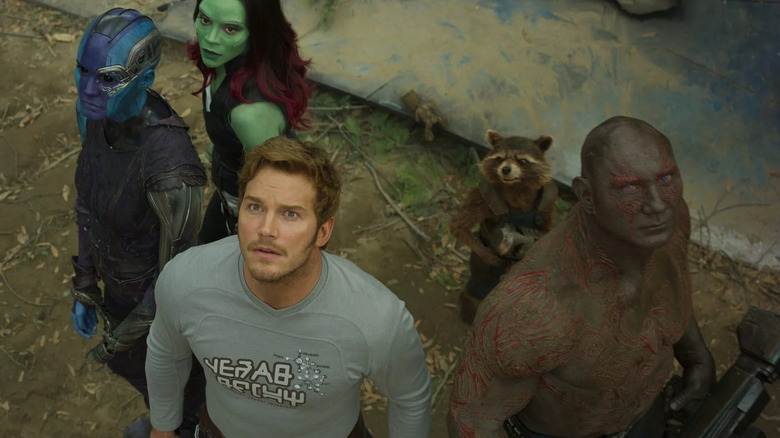
After nearly ten years, James Gunn's "Guardians of the Galaxy" is finally coming to a close, as "Guardians of the Galaxy Vol. 3" has officially hit picture wrap. The director took to Twitter to make the announcement, including a cast photo featuring Sean Gunn, Pom Klementieff, James Gunn, Chris Pratt, Karen Gillan, and Dave Bautista all sharing a celebratory drink to mark the end of principal photography. The 32nd film in the Marvel Cinematic Universe, "Guardians of the Galaxy Vol. 3" will conclude the main storyline of Star-Lord, Gamora, Nebula, Drax, Rocket Raccoon, Groot, and Mantis, while the characters will likely pop up in other Marvel projects in the following years.
And that’s a picture wrap on the Guardians of the Galaxy trilogy. I love this amazing cast & crew & their beautiful talent & kind souls. I’m a lucky human to have them on the journey with me for nearly a decade. pic.twitter.com/oVQCIfJjuZ
— James Gunn (@JamesGunn) May 7, 2022
Many fans quickly noticed that Zoe Saldana, who plays Gamora in the trilogy, was absent from the commemorative cast photo. Before speculation could get the better of anyone, Gunn quickly cleared the air by confessing that he only has one personal on-set photo of Saldana, but it included her alongside an unannounced actor on the project. Gunn then tweeted out a polaroid of Saldana hugging actor Jennifer Holland, who is known for playing Emilia Harcourt on Gunn's DCEU series "Peacemaker" for HBO Max.
This led to even more speculation that Holland herself would be joining the team, which Gunn clarified by tweeting, "No no not Jenn. I mean the only picture I have with her and me - this is from the same night." Not that it wasn't already assumed, but this confirms that there's going to be a pretty cool character added to the final film that has yet to be announced. Time to speculate wildly.
Who Is The Unannounced Actor In Vol. 3?
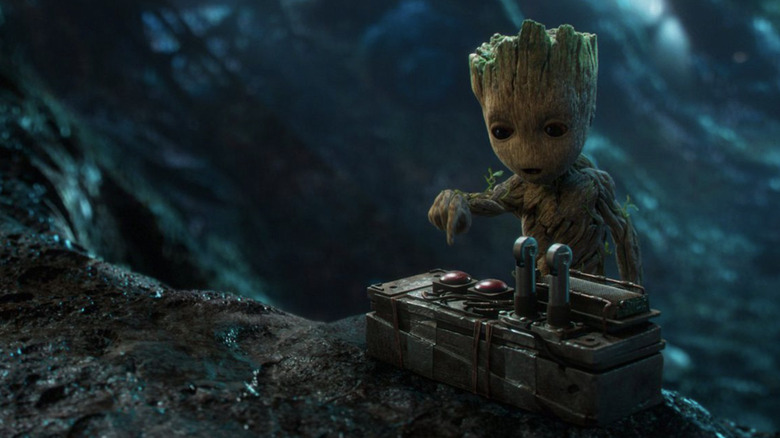
A few days ago, Karen Gillan said that "Guardians of the Galaxy Vol. 3" was likely going to be the end of Nebula's story, and many have been speculating that "Vol. 3" will highlight the relationship she has with Saldana's Gamora. If the only photo available of Saldana is with an unannounced actor, it's likely that Saldana spends a lot of time with them in the film.
If I had to make a guess, perhaps we'll be introduced to one of the many children Thanos "adopted," since that dude collected kids like the Butkis family in the Mary-Kate and Ashley movie "It Takes Two." (Shout out to the four of you who got that joke.) Gunn previously announced that "Vol. 3" had broken the Guinness World Record previously set by "How the Grinch Stole Christmas" for most makeup appliances created for a single production.
Perhaps this will be because we're going to meet all the siblings?!
Okay, that's admittedly a farfetched prediction, but Nebula and Gamora have already lost so much in their lives and they deserve some joy. Thinking about the two of them getting the chance to reunite with all of their fellow intergalactic orphaned siblings gives me warm fuzzies and it's fun to dream! Realistically, it's probably going to be a character that's either being shown for the first time and will continue on in future Marvel projects, or an existing MCU character showing up into their world for fun cameo crossover goodness. And before anyone gets too excited, Gunn has already confirmed that Michael Rooker will not return as Yondu, as much as we'd love to see him ... but that doesn't mean he isn't playing someone else?!
Come on, a gal can dream.
Read this next: Every Star Trek Show And Movie In Chronological Order
The post Guardians of the Galaxy Vol. 3 Wraps Shooting, Teases Unannounced Actor appeared first on /Film.
I Think You Should Leave Renewed For Season 3, Because Triples Makes It Safe, Triples Is Best
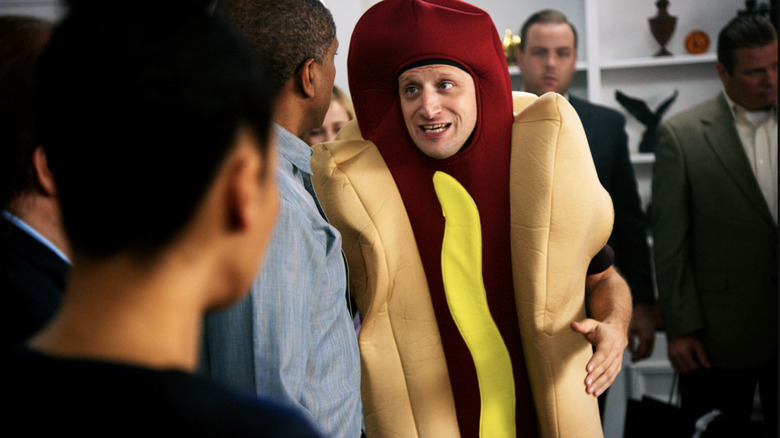
After a week of what felt like nothing but bad news and cancellations over at Netflix, a beacon of hope shines brightly through the doom and destruction. I don't want anybody to have the worst day at their job, which is why the announcement from Variety that savior of the people, Tim Robinson, will return for a third season of his brilliant sketch show, "I Think You Should Leave" is something worth screaming about. The hit series comes from the former "Saturday Night Live" featured player and fellow SNL writer and "Detroiters" co-creator Zack Kanin, who deliver an eclectic mix of offbeat sketches highlighting characters that really, really need to get the f*** out of the scene and spare the awkward conflict. Robinson's brand of humor may be too strange for comedy normies, but for the equally warped weirdos who like this sort of thing (Hi, hello) "I Think You Should Leave" is a bright star in this dark world.
— claytron (@Mondo_1) May 6, 2022
The news came from cast member Sam Richardson ("Werewolves Within," "The Afterparty") who told Variety that the writing team had begun writing for the third season back in March. There's yet to be any confirmation on how many episodes the new season will bring or when we can expect the third season, but even knowing that "I Think You Should Leave" is not getting destroyed in the great Netflix purge of 2022 is worth cheering about. "I'm not sure when they'll start filming," said Richardson. "But there are funny sketches coming already, I can tell you that much."
'Here Comes A Big Wave'
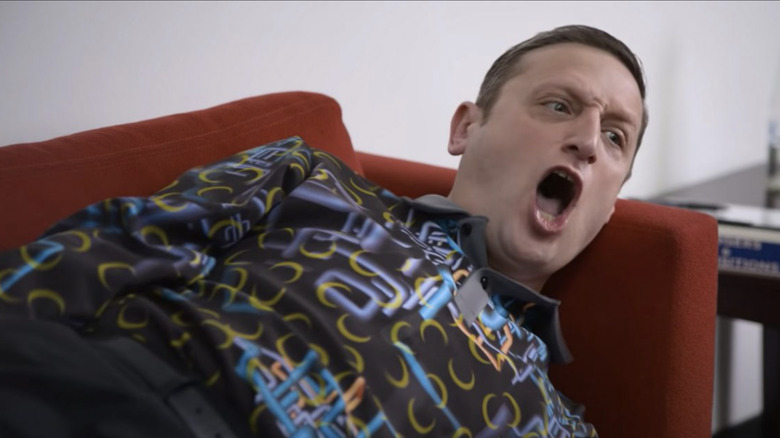
Robinson may have only enjoyed a single-season at "Saturday Night Live," but his post-SNL career has been glorious. In addition to "I Think You Should Leave," Robinson and Kanin nabbed a comedy pilot called "Computer School" for HBO Max, about a high school graduate and his uncle (Robinson) who wind up in the same computer class in the Midwest. Robinson and Kanin are writing the pilot, so there's a high probability that it'll be just as odd and outlandish as the sketch show that made them comedy darlings.
Akiva Schaffer, Andy Samberg, and Jorma Taccone (The Lonely Island), and Ali Bell for Party Over Here serve as executive producers on "I Think You Should Leave" along with Alex Bach and Dan Powell for Irony Point. Alice Mathias serves as executive producer and directs many of the sketches alongside Kanin.
In case you're worried that Richardson's statements weren't enough, Netflix took to Twitter to confirm the announcement, because sometimes massive corporations still do things that bring us happiness in order to keep our monthly subscription payments.
Here's some good news for your Fri...day night. I Think You Should Leave with Tim Robinson has been renewed for Season 3! pic.twitter.com/BcHwd5Nl64
— Netflix Is A Joke (@NetflixIsAJoke) May 6, 2022
Read this next: The 15 Best '90s Comedies Ranked
The post I Think You Should Leave Renewed for Season 3, Because Triples Makes It Safe, Triples is Best appeared first on /Film.
[Series Review] CANDY

True crime is a popular guilty pleasure for viewers. Morbid curiosity, especially when it comes to the more sensational cases, naturally draws attention. Whether due to a need to understand the criminal or what have you, it can’t be denied that there’s plenty out there to sate our true crime needs. And, with plenty of adaptations coming out this year alone, true crime fans are going to be fed. But, with the bounty of true crime works available, it’s becoming easier to sift through what’s worth the time and what isn’t. In the case of Hulu’s upcoming limited series titled CANDY, it’s a difficult sell. With uneven pacing, questionable character direction and development, and its abrupt cut-off style ending, the series ends up floundering. But many will stay hooked as Jessica Biel knocks out another great performance here as the titular Candy.
The series does start off strong. The first episode is fraught with slow boil levels of tension and important character information. Through Biel’s first monologue in the series, you get a glimpse of the inner workings of Candy Montgomery’s mind. The story she tells paints early on is something to pay attention to as you watch the series unfold onscreen. She’s not the only one to shine, though, in the episode. Pablo Schreiber’s Allen Gore is steadily anxious. We feel the mounting anxiety the character feels as his phone calls to his wife go unanswered. While she gets less screentime in the opening episode, the presence of Melanie Lynskey’s Betty Gore can be felt. And, with the sound design and score from Ariel Marx, there’s a haunting feeling that isn’t easily shaken off.
Episodes 2 and 3 shift backward, focusing on the build-up leading up to the climactic event. Here we see the relationship building between Candy Montgomery, Allen Gore, and Betty Gore, but we also get further insight into how the two women in particular view their current status in life. Biel and Lynskey shine in these scenes, with Biel’s subtle microexpressions showcasing the calculated nature of Candy as she moves about the community. You can see when her mask slips, and it is in these moments that she is particularly chilling onscreen. Where things start to fall apart, though, is when we jump back to the murder investigation.

While Biel’s Candy captivates still in the final two episodes, all other major players fall to the sidelines. Schreiber’s Allen Gore almost fades away, joining his deceased wife in some ways with being erased from the narrative in some ways. Confusion resounds, in particular, with Timothy Simon’s Pat Montgomery. There’s not much depth to the character itself, and it’s difficult to say how much of it is the writing or the direction. He evolves a little beyond the surface level once the investigation into this wife begins but the change, much like the shifting tones in CANDY, reads as abrupt and unearned. This note can also be applied to the show’s finale as it speeds quickly through the court scenes. It moves so quickly you almost miss Raúl Esparza’s dramatic command of the court.
Would CANDY have benefited from an additional episode or two? Probably. This might have helped with the development of certain characters as well as fixing the tonal identity issue the series has. There’s a question as to what kind of tone the creators were trying to gun for in this upon the completion of the series’ final episode. A strong, consistent performance from the cast helps keep the viewer interested. The relevance of those performances dies out once the characters surrounding Candy Montgomery fade into view post-murder. This despite Biel still aptly commanding the screen. With the series clocking in at just five episodes, it’s still highly recommended given what the cast and below-the-line crew invest into the work audiences get to see. The lack of an identity, however, makes it difficult to remember much once the credits roll.
CANDY will debut with its first episode on Monday, May 9, on Hulu, followed by one new episode daily until the finale on Friday, May 13.
The post [Series Review] CANDY appeared first on Nightmarish Conjurings.
Psy's Catchy New Video With Suga of BTS Smashes Past 100 Million Views - CNET
Eve Online will tee up its third decade with advanced faction warfare and ambitious story arcs
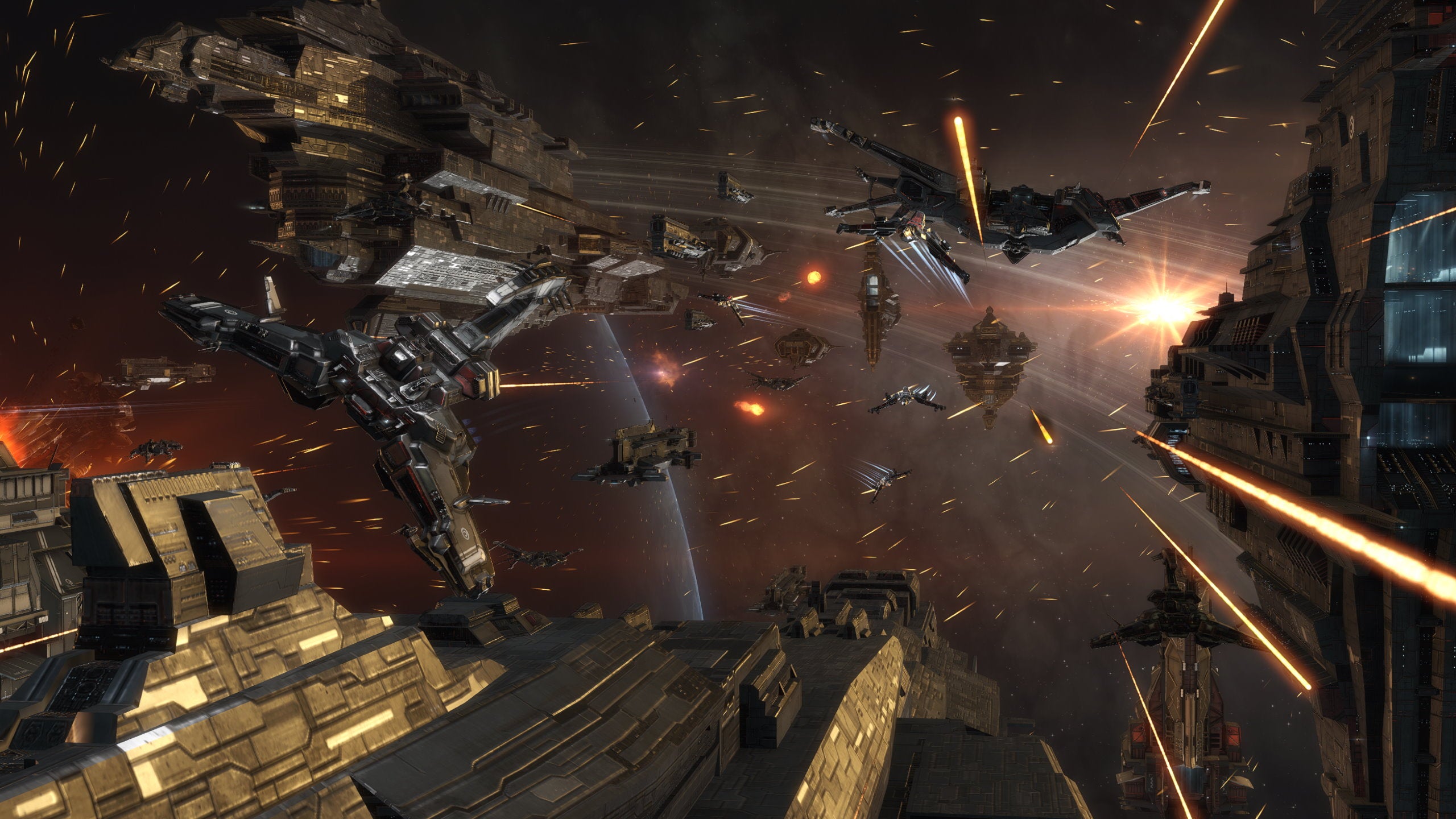
Eve Online, the space MMO that’s so laden with consequence it’s frightening, is introducing multi-year story arcs to pull its NPC factions into the heart of the game. The finale of developer CCP’s first planned arc will launch before the end of 2022. The idea is to let capsuleers build meaningful bonds with their home empires by fighting for them in New Eden’s living universe - which has always been shaped by players, not NPCs.
The Wilds Creator And Showrunner Discuss The Daunting Decision To Introduce Boys [Interview]
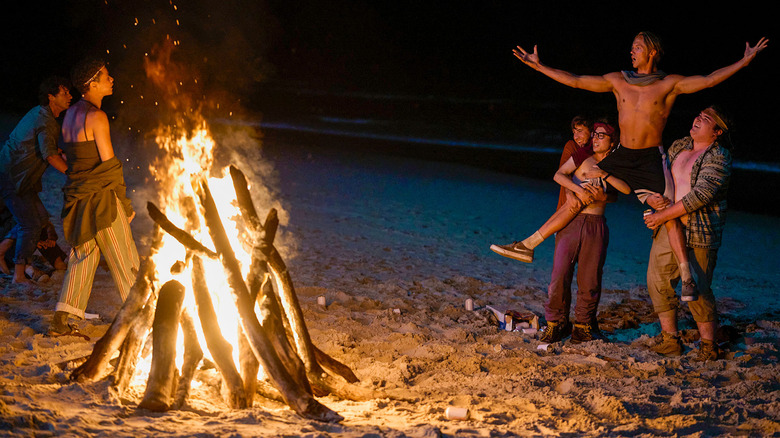
"The Wilds" is a coming-of-age story with a special twist: The eight lead characters are stranded on a deserted island as part of an insanely devised social experiment. Minus the whole fighting for survival detail, the first 10-episodes of the show are very focused on the teenage girls at its center: Who were they back in the real world, and what led them to board the plane? Over the course of the first season, both flashbacks and the relationships they build on the island reveal them to be a compelling bunch of individuals, with a range of stories to share. Forced together, they grow in ways they never could've foreseen.
The thriller element of the series is certainly enticing -- the conspiracy of it all goes deep, and the show slowly lets us in on the people behind the terrible experiment — but the real appeal is the journey of the girls, as they learn to build a life for themselves in the middle of nowhere. Renewed for a second season, series creator Sarah Streicher ("Daredevil," "Turning Red") and executive producer/showrunner/writer Amy B. Harris ("Sex and the City") decided to shake things up by complicating the status quo. The second season introduces a new ensemble of characters, whose stories become a crucial facet in the next chapter: The puppet-master behind the experiment, Gretchen Klein, has arranged more than one group of teenagers on a remote island. Separate from the girls are a group of boys that she dubs the Twilight of Adams. They're meant to be a counterpart to the girls, who are the Dawn of Eve. This means getting the audience invested in eight new teens and watching yet another survival tale unfold. /Film spoke to Streicher and Harris about all that went into their decision, and how they approached this big change.
'The Onus Was On Me To Make Them As Human And Complex And Rich And Flawed As Possible'
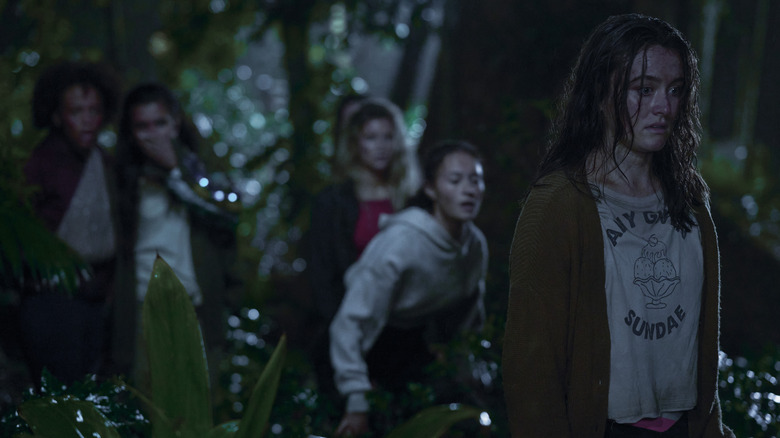
So, the first season is really digging into these eight girls on the island and their backstories and the flash-forwards. And then in season 2 we're doing all that, but we have this new element of the Twilight of Adam boys. What was it like to make that big addition of eight new characters and new storylines?
Both: Daunting.
Streicher: [laughs] Daunting, indeed. I spent so much time with creating those women. The onus was on me to make them as human and complex and rich and flawed as possible. The mortal sin is in characterization. And so, having to do that again with that bar set high was enormously daunting. I also know that among the fandom there's some worry and pushback about the addition of the men. I hear that so deeply and I understand that. But what I like about what we've done, and what I'm excited about, is that the women are the primary actors in this environment. It's sort of like they're the forefront, they're the pioneers, and then the guys are this counterpoint. So usually, it's the other way around — you have the male experience and then the female counterpoint. So it's exciting that we've flipped it a bit on that angle.
Harris: Yeah, I think for us, from a production standpoint, casting eight new people after such a beautiful, really specific cast was built for the first season, that was a huge challenge for us and one where I felt like if we didn't nail it ... I never said this to Sarah, but I was like, "We might have to abandon it if we don't find those male actors to do this," because to do a disservice to the first season [wasn't what we wanted]. And luckily, we have a brilliant casting director, and the right people came and the alchemy was there. So it was pretty exciting.
I'm curious about that counterpoint idea that you brought up, because I know we know that Gretchen's goal is for the boys to fail and prove her right. But for you, what was the goal from a storytelling perspective?
Harris: Well, I think the most exciting thing for me was that because the girls had already gone through it, we could skip a lot of the expositional steps because the audience was already there. So the plane crash, they knew that's what happened, they knew there was somebody set them up. So on the one hand we didn't have the same mystery of, "Why are these girls on a stranded island and what seems weird?" and then the reveal of Gretchen. But what made it so exciting is because there was that shorthand, we could really show the difference between how the boys' and girls' islands dealt with things.
So we know the girls did this for water or for sustenance, and now we're watching in a counterpoint kind of way — the way Sarah said — how the boys are doing it. So for me, that was exciting. That we're watching them in relation to the girls, as opposed to the girls where we were just in their experiences. I think that was very important to us and I think that's kind of Gretchen's goal, too, is that she's watching to see and she's crossed fingers that they're doing it badly and the girls do it better. So we sort of tried to be in Gretchen's eyes when we started setting up how we would experience the boy's island.
Season 2 of "The Wilds" is now streaming on Prime Video.
Read this next: 20 Movies About Time Travel Ranked Worst To Best
The post The Wilds Creator and Showrunner Discuss The Daunting Decision To Introduce Boys [Interview] appeared first on /Film.
Mr. Saturday Night Review: Billy Crystal Dances And Sings Within His Comfort Zone On Broadway

Should Murphy's Law send a meteor shower upon Billy Crystal, the show can't go on. When I peered through the playbill at the Nederlander Theatre, it lists no stand-ins for Crystal. Lose Crystal and the show loses its heart.
Enter Billy Crystal as Buddy Young, Jr. in "Mr. Saturday Night," the 1992 Castle Rock Entertainment box office flop that starred him and served as his directorial debut. Come 2022, he and his team give the movie the stage musical treatment on Broadway. As in the film, the musical charts the attempted resurgence of the Borscht Belt television comedian Buddy Young, Jr., who evolved from a 1984 character Crystal created for "A Comic's Line" special.
Old Material

Beginning with an old washed-up Buddy performing stand-up at retirement homes, the show is set in a 1994 New York City and has flashbacks from the late 1940s to early 1950s. In the adapted book of Crystal's screenplay with his original co-screenwriters Lowell Ganz and Babaloo Mandel, new and old materials settle in. The funniest new material is the hilarity of an Emmy "In Memoriam" montage that erroneously honors Buddy as among the dead. The error leads to shenanigans of neighbor condolences, but it most importantly reconnects two estranged brothers and launches Buddy's possible resurgence. Some old material from the movie brings in some laughs: the movie's Beatles sequence is compacted into a funny anecdote.
As someone who didn't connect to the average-but-competent-enough watchable film, I wondered about the commercial and artistic motivation to stage musicalize this three-decades-old film. But once I saw Crystal, no need for the old age film makeup, his hair whitened, smiles and grimaces weathered with age, and a mouth that has not lost its acuity for quips, "Mr. Saturday Night" is now more poignantly about growing old with yourself, your faults, your loved ones, your audience, and your work. You can tell that Buddy's physical and verbal quips about the aging body resonate with Crystal himself and his older audience. This is supported by David Paymer's reprisal as Billy's onscreen brother and agent of five decades, Stan Yankleman. Though Paymer may be adjusting to theatrical movement and has to act through his singing, he's at comfy ease with the role that got him an Academy Award nomination. His rapport with Crystal has only matured, not melted, through the years.
John Rando directs the show with little obstructions. Ellenore Scott supplies Crystal and Paymer lite kicks choreography that stays within their threshold. An economical collective of screen projections sweeps in photographic and archival visuals (video & projection design by Jeff Sugg) among Scott Pask's classy scenic design.
Flanked by a three-person ensemble (Jordan Gelber, Mylinda Hull, and Brian Gonzales), Crystal and Paymer are surrounded by a heartfelt main cast. Randy Graff is also a delight as Buddy's wife who carries her own sense of humor. The great Shoshana Bean recognizes the confinement of her role as Buddy's quasi-estranged daughter Susan but she still knocks it out of the park. The agent Annie Wells (played by Helen Hunt in the film) is played by Chasten Harmon in her Broadway debut. She exudes a bubbly charm but she gets the short end of the stick. Her purpose is also quite suspect that Crystal and the writers should have rethought. They have written Harmon a role in which she, a Black agent, is un-versed in comic history so he, an older white man, can school her. As a result, I'm questioning why she sees their partnership as worth compromising her mental health for.
For a great cast, it is unfortunate that Jason Robert Brown's serviceable music and Amanda Green's lyricism do little to elevate. Buddy's motive song "A Little Joy" is bland. There are songs where the simplicity is the sincerity: Crystal's "Any Man But Me" where Buddy humbles himself into an epiphany and Crystal and Graff's marital duet "My Wonderful Pain."
The musical bears a little less of the structural issues of the movie, which veered into extended flashbacks less on dramatic or reflective instinct but more on convenience. Crystal, Paymer, and Graff don't overstrain by not bothering with evincing a youthful effect in scenes where they're decades younger. There is one Act 2 opener that pairs Crystal and Bean for a flashback that requires the latter to dissolve into a 5-year-old self, and Bean navigates it marvelously with the dimensions of fond nostalgia, mixed emotions, pent-up reminiscing where any actress could overplay it as a gimmick. Had she not stuck the landing, the rest of the father-daughter conflict would not have hit.
Self-reflection
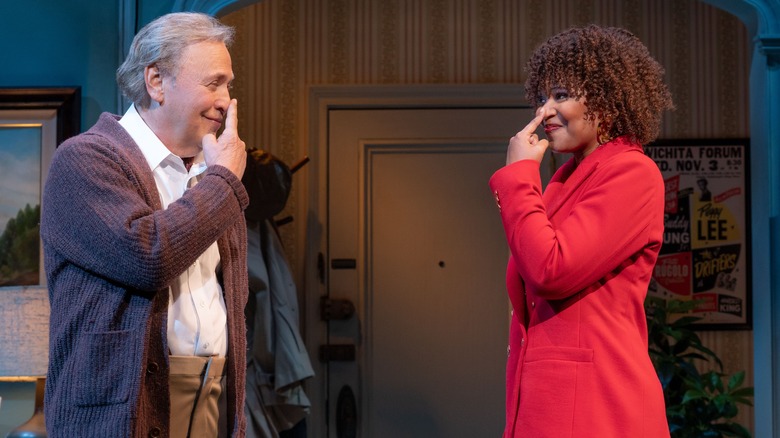
If you consciously covet the theatre ticket, you likely already have a relationship with Billy Crystal. Many in the room (an audience decades my senior) probably are chummier with Crystal as their long-time stand-up comedian, Oscar-Grammy host, and the lead of the autobiographical Tony-winning one-man "700 Sundays." My Crystal has always been the quotable movie wisecrackers like Miracle Max or Mike Wazowski.
And this brings me to the shortcoming: For newbies (twentysomethings like me), I didn't feel transportive into Buddy's heydays. And I admit I'm not Crystal's target audience. When Crystal sings about the comic greats in "Timing," I didn't feel the specifics, nor do the lyrics illuminate. It leans on the audience's assumed prior knowledge to get Billy's, ahem, Buddy's drift—cue projected photographs of classic comic figures. I do highly suspect more era-specific humor would not be inviting to me, a Vietnamese woman, and the team would rather it fly its problematics over the head than let us sit on its implications. "I'm here to make you feel at ease, what am I, speaking in Chinese?," a 1955 Buddy sings casually in "A Little Joy." It's the last lyric that should thoughtlessly slip through during a time of anti-Asian sentiment.
Though it doesn't cover for the show's flaws, Crystal does carry that special gift of playing a jerk who is open to learning and absorbing. As he does in "When Harry Met Sally," he can bottle his un-nicety into proportion and playfully straddle the line between likable and despicable territory and yet not tip over into the other side. This is a story where the comedian realizes after all that he should validate criticism from his loved ones. Believe it or not, I argue it's a hindrance to oversoften Buddy in Act 1 compared to the movie. For a story that is about a comedian's coming-of-age and self-reflection, it comes off like a missed opportunity that the material doesn't double down on examining the bawdy comic medium itself, considering how comedy itself has been undergoing a reckoning over punch-downs. Other than Buddy's daughter addressing her father's ridiculing of people with certain appearances (that seems to meta-acknowledge how Buddy Young targets people's weight in the film), the writing team appears to be aware they are not equipped for deeper soul-searching within Buddy's profession.
A few pedestrian songs too long for its concept, "Mr. Saturday Night" has more potential in a tighter show. Act 1 grows sleepy before Act 2 lets Buddy reflect on his behavior. Both movie and show end with the comedian eating a humble pie and settling for his lot in life. So it seems indulgent to reverse the movie's ending to reward a lash-out that was illustrated as overstepping—especially since Paymer's callout, "You could have been nicer," still hits and sparks that epiphany as effectively as it does in the film. I can't completely fault Crystal and his writing team for giving an aging man his fantasy but the easy journey there is as critique-able as the comedy.
"Mr. Saturday Night" is playing on Broadway at the Nederlander Theatre.
Read this next: The Best Movies Streaming Right Now: Malignant, A Hero, And More
The post Mr. Saturday Night Review: Billy Crystal Dances and Sings Within His Comfort Zone on Broadway appeared first on /Film.
How Much Of A Sam Raimi Movie Is Doctor Strange In The Multiverse Of Madness?
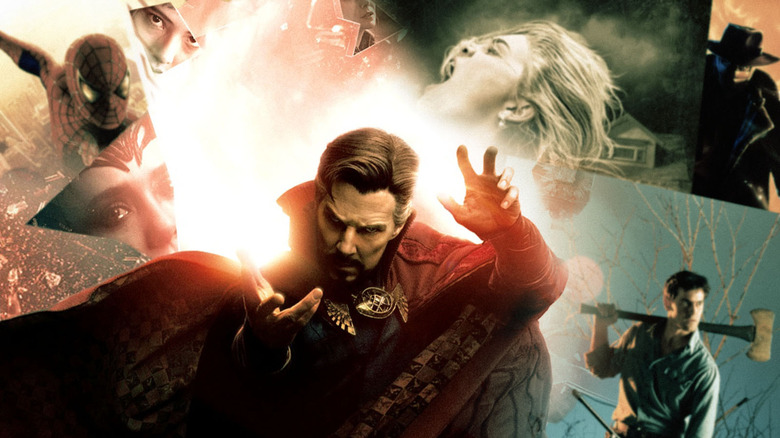
"Doctor Strange in the Multiverse of Madness" is officially in theaters, and with Sam Raimi as director, many are curious to see how well his signature style comes through amid the Marvel Cinematic Universe formula. There will absolutely be spoilers ahead, so if you don't want to know plot points, please save this article and watch the film first.
In "Multiverse of Madness," Doctor Stephen Strange (Benedict Cumberbatch) is dealing with a rogue Wanda Maximoff, aka Scarlet Witch, who is trying to steal the powers of America Chavez (Xochitl Gomez), who can blast open star-shaped portals to other parts of the multiverse -- but only when she's terrified. Wanda just wants to be with her children again, but let's just say that while her motives make a kind of twisted sense, her methods are pretty awful. Strange and America travel through the multiverse trying to stop her, and huge battles ensue. Oh, and there's a cursed book that brings doom on anyone who tries to read it. If that isn't open to Sam Raimi's signature style, I don't know what Marvel movie is!
Raimi, Now With Extra Raimi
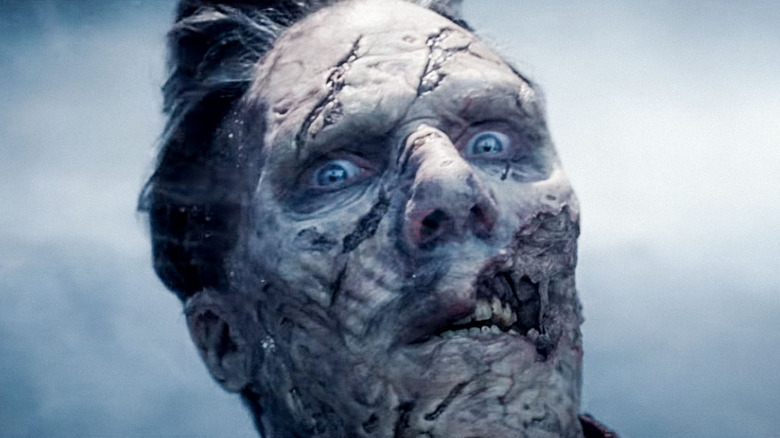
"Doctor Strange in the Multiverse of Madness" is a Raimi film in the same way "Thor: Ragnarok" was a Taika Waititi film or "Guardians of the Galaxy" is a James Gunn film. It's about as Raimi-esque as it is possible to be, given the constraints of the MCU. As Raimi himself explained in an interview with /Film:
"This is an existing series with established characters and a fan base. And the job is to complete mile 16 of a bridge that had been under construction for 15 years. And it takes a different set of skills to do that. It's got to work with what went before. It's got to lead into what's coming. It's got to be handled to hold the same audience expectations that those other films did."
Despite these demands, Raimi still managed to put his personal touch on "Multiverse of Madness." Let's start with the darkness/horror levels here. Obviously Raimi is associated with horror thanks to movies like the "Evil Dead" trilogy and "Drag Me to Hell," and there is a lot of horror DNA in this film. Many fans have been asking for a darker MCU film, and while "Doctor Strange in the Multiverse of Madness" retains Raimi's sense of humor, there are definitely enough scary elements that I wouldn't necessarily bring your little ones to this film. Someone gets cut in half, eyeballs get skewered, screaming souls of the damned reach out with ghostly fingers to drag people to hell -- that sort of thing (though the blood is kept to a minimum).
One thing Raimi is really good at throughout his films is making scary stuff very personal and visceral. He uses POV shots to give the audience a front seat when scary things happen, as Hitchcock used to do. (Think about the shower scene in "Psycho," where we see the hand and the knife, but it's not an overhead shot -- you feel like you're right in it.) Raimi once again uses a subjective camera angle in "Multiverse of Madness." In the scene with the souls of the damned floating around an undead Doctor Strange, you feel like they're coming at you, the audience member.
We've definitely got an "Evil Dead" franchise feel here with the spirits, with hands reaching out of the ground like Deadites, the skittering they do, flying around with high-pitched laughter, and people swatting at them. Even Dead Strange is a Deadite of sorts, and as he does sometimes in his other films, Raimi has him speaking almost directly to the camera at times. We don't cut away from his decaying face at all while he does a monologue. There is no shadow that hides him. He's just there, with half of his face gone, teeth apparent. Even Wanda (Elizabeth Olsen), as she gets more and more evil, begins to look like a zombie -- drained of the joy in life that kept her in her imaginary world with her children in "WandaVision."
Zolly Zombies
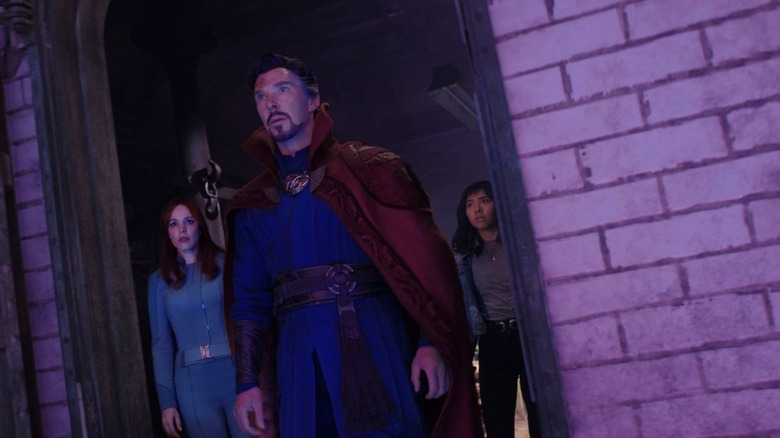
A lot of his camera work in "Doctor Strange in the Multiverse of Madness" is what we've come to expect from Raimi. In addition to fast and sudden zooms in general, there's a specific technique he uses a lot called a dolly zoom, vertigo shot, or "zolly shot." This is when the zoom lens is pushed in while camera itself moves away (or vice versa), and the resulting effect creates the impression that the world itself is shifting. Our brains recognize this movement as impossible and unnatural, and it causes a sense of unease and disorientation in the viewer.
Think about how we saw Peter Parker's (Tobey Maguire) Spider-Sense shown in the Raimi "Spider-Man" films. For instance, the scene where he and Mary Jane (Kirsten Dunst) are sitting in the cafe, and he realizes the car is coming in through the window. The shot zooms out, but we also zoom in on his face. In "Multiverse of Madness," we see this with the tentacles in the Gargantos attack scene, as Strange reaches for the light post, and as the camera tracks past Strange into the eye.
We also get a lot of Dutch angles, where the camera is tilted to the right or left, as it does when Christine, America, and Strange are running through hallways as they're being chased by Scarlet Witch. Like the zolly shot, Dutch angles are contrary to the "rules" of how we usually see the world and give the illusion of everything being off-kilter, like the tilted hallways in funhouses.
Keeping with the funhouse theme, Raimi uses a lot of swirling shots to give a feeling of unreality, as he does when Ash gets possessed by a Deadite in "Evil Dead II." It happens in "Doctor Strange" with the dead spirits swirling around Strange, or at the beginning of the trailer, where the camera spins around a door to the space between the universes (called the "gap junction") where the Book of Vishanti resides. There are also a lot of camera speed changes to punctuate a realization, like the moment Wanda realizes that she's trapped in the mirrors, or in the moments as Strange and America drift through universes.
Into The Eyes Of Madness
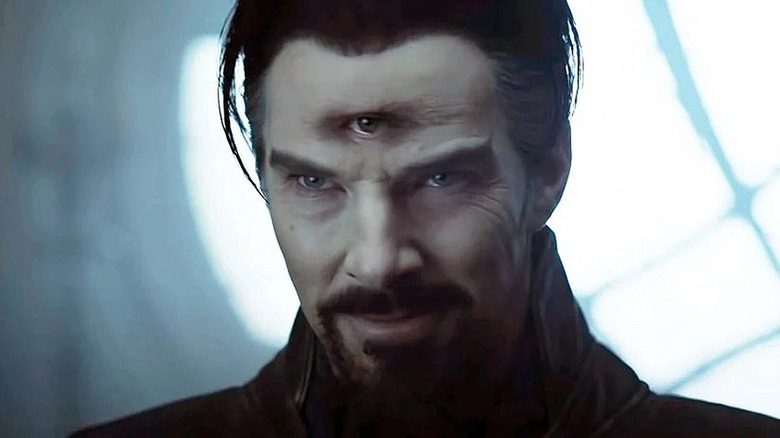
Sam Raimi is a big fan of extreme close-ups on eyes (as seen, for example, with Willem Dafoe's Green Goblin in "Spider-Man"), and those find their way into "Multiverse of Madness." In one such shot, we go directly into a shot of Wanda's eye, reflecting what she's seeing in Christine's lab. Raimi is the master of clever transitions, and the eye close-ups play into this as well; you get a close shot into the eye that then transitions into another scene (or vice versa).
Extreme closeups like this give a sense of panic (something that close talkers do to me for the same reason), because you lose your sense of personal space. Raimi's use of close-ups during particularly dramatic moments also alights on the idea of making tragedy or death or pain more personal, and therefore more real and powerful. You make the viewer feel like they're there, and they're more likely to remember it.
Bruuuuuuce!
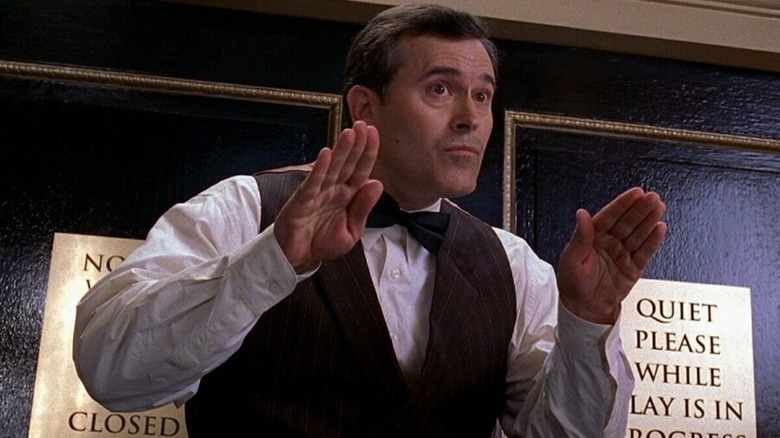
Of course there is a Bruce Campbell cameo in here! Raimi puts the "Evil Dead" star in most of his films if he can, and "Doctor Strange in the Multiverse of Madness" is no exception. Campbell plays a street food vendor called Pizza Poppa in the Earth-838 universe that Doctor Strange and America Chavez visit. Pizza is not served in slices there, but instead in balls. I don't know that I would be willing to eat that, or how it even works, physics-wise. Does the cheese slide everywhere? Where is the bread? How does it stay in a ball-shape? I have questions. Whatever the science behind pizza balls is, Campbell's Pizza Poppa is selling them off a food cart.
His cameos are often funny, like the snooty usher in "Spider-Man 2," or the Winkie Guard in "Oz the Great and Powerful," and this one is no exception. Pizza Poppa wants to get paid for his pizza balls, but America didn't realize that food costs money in this universe. Then Strange makes him continually punch himself in the face (it will wear off in a month or so) for getting mad at them for stealing his balls. You have to feel for Mr. Poppa. He's just trying to sell his balls in peace, and a wizard and a kid come along and just take them? How's a pizza ball cart owner supposed to do business that way?
Love And Monsters
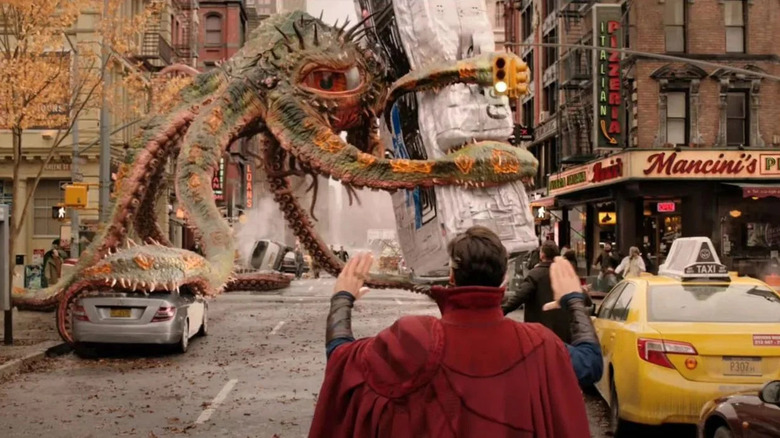
Sam Raimi is obviously an old hand at monster scenes and making you feel like they're right there next to you. The Gargantos fight makes you feel the way the Deadites did: right on top of you, and moving with speed. The tentacles are right in your face in the battle. If you revisit Doctor Octopus (Alfred Molina) in "Spider-Man 2", you'll see shots of those arms coming at you in the same way. It's all part of Raimi's visual language. The same goes for the grasping hands in the cape of damned souls that Dead Strange wears.
One more crucial thing that Raimi does, though it's often not commented on, is center his horror emotionally. It's classic storytelling. Though the story might not be grounded in reality, his characters are genuine (if larger than life), and love is often a big part of his stories, from the found family themes of "Ash vs. Evil Dead," to how Peter and MJ work things out in the "Spider-Man" movies.
In "Doctor Strange," America finds a new family through her friendship with Strange(s). Though Steven realizes that he and Christine are never going to work it out in any universe, their parting isn't volatile or angry. There is a sense of sweetness as he tells her, "I love you ... in every universe." It's earnest, and it's lovely. Sure, everyone loves a big, bombastic story, but at the heart of it, storytelling is about relationships. Even the moment Steven thinks that maybe this other universe's version of Mordo (Chiwetel Ejiofor) might be close to the other Strange is sweet (though ultimately wrong). Or the moment Black Bolt (Anson Mount) executes Earth-838's Strange, and does so with an apology for hurting his friend.
Sure, "Doctor Strange in the Multiverse of Madness" is a Marvel film, and gore isn't really a part of that mostly kid-friendly world. We have dust instead of blood most of the time, and more of a sense of weirdness than gory horror, but this is about as Raimi as you can get in the MCU, and his stamp is all over it.
"Doctor Strange in the Multiverse of Madness" is in theaters now.
Read this next: Every MCU Post-Credits Sequence Ranked From Worst To Best
The post How Much of a Sam Raimi Movie Is Doctor Strange in the Multiverse of Madness? appeared first on /Film.
05/06/2022
Many now think that the new stress system is too easy, but I doubt anyone wants to return to the days when annoying red arrows meant your fort was doomed. We have changed the system into something different than both of these extremes. But more importantly, we are going to show you what's actually going on instead of letting flashing arrows drive you crazy.
First of all, even in the easy version of the stress system, there is a spectrum of emotions that (like most complex systems in DF) was hidden under the surface. You may or may not be following the Steam news, but now we have a string of smiley faces representing your dwarves' immediate emotional state.
Mayor's sheet (with many new icons by Carolyn, who has been working on the interface)
You can see the spread of varied emotions in this fort. This is the best I could do after 7 years, and 200 dwarves, giving them everything their little hearts desired. With a detailed thought and memory tab you can see what brought them to the state they are in. For example, one of my angriest dwarves was the mayor who hated that I gave the count his posh office and was outraged that I had convicted a goose of being drunk and disorderly. You might not be able to please everyone, but at least there are no more blinking arrows.
Who Is Rintrah From Doctor Strange In The Multiverse Of Madness? The Extradimensional Being Explained
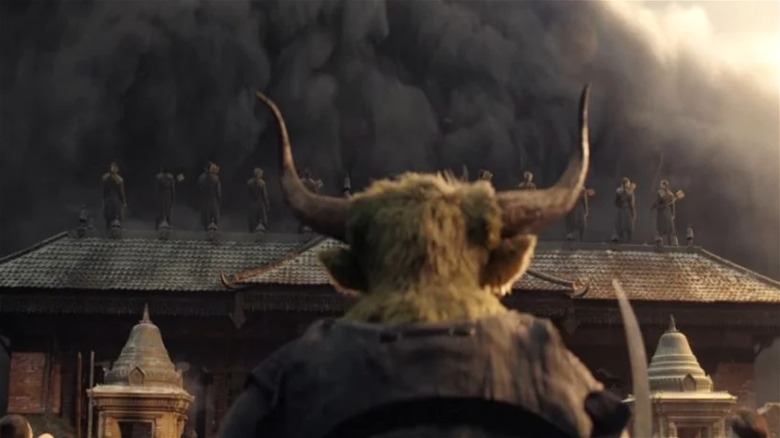
Warning: Major SPOILERS ahead for "Doctor Strange in the Multiverse of Madness."
The MCU has been home to various mystical creatures and interdimensional beings, some of which are taken from Marvel Comics lore, while either being developed further or referenced in passing as a fun callback or Easter egg. Sam Raimi's "Doctor Strange in the Multiverse of Madness" is rife with twists and surprises, some of which were already glimpsed via the teaser trailers and rumors surrounding unexpected cameos.
An interdimensional being who is prominently featured in one of the scenes, yet does not quite play a major narrative role, is Rintrah. In case you're unsure, Rintrah is the large, green-ish minotaur-like creature fighting alongside the sorcerers at Kamar-Taj when Wanda (Elizabeth Olsen) attacks the fortress.
We see glimpses of his horned head many a time, but he doesn't do much apart from fight and look cool. But the connections between this being and Stephen Strange are deeper than you think (at least according to the Marvel comics).
A Powerful Magician Apprentice
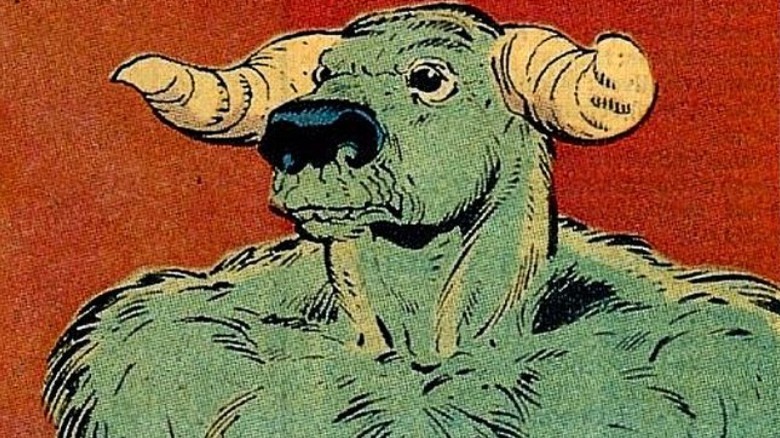
Rintrah was first referenced in "Doctor Strange" #80, in its September 1986 issue, and the character was created by Peter Gillis and Chris Warner. An intelligent being from the planet of R'Vaal, Rintrah's kind resembled green-skinned minotaurs but exhibited physical characteristics that eclipsed this particular description. His magical potential was noticed by Enitharmon the Weaver, a sorcerer from a different dimension, who decided to train him in the mystical arts and took him in as an apprentice.
This begs the question: how and when did Rintrah run into Earth-616's Strange in the comics? Strange had happened to rip apart his Cloak of Levitation (the poor thing has gone through the ringer, even in the film), and had gone to Enitharmon to repair it, after which the latter asked Rintrah to return the repaired cloak back to the sorcerer. However, things go awry when Strange was wounded by a demon by Urthona, an alien mystic, which led to him parting with his astral body and sharing a consciousness with Rintrah eventually (this minotaur rules, not gonna lie).
While Strange had initially refused to take in Rintrah as an apprentice, due to the usual shenanigans with other malevolent forces back on Earth, Rintrah ended up studying at Kamar-Taj while Strange was busy battling evil. This explains his presence in "Multiverse of Madness," and the loyalty he displays towards the sorcerers, despite hailing from a different interdimensional planet.
Rintrah Is Not To Be Underestimated
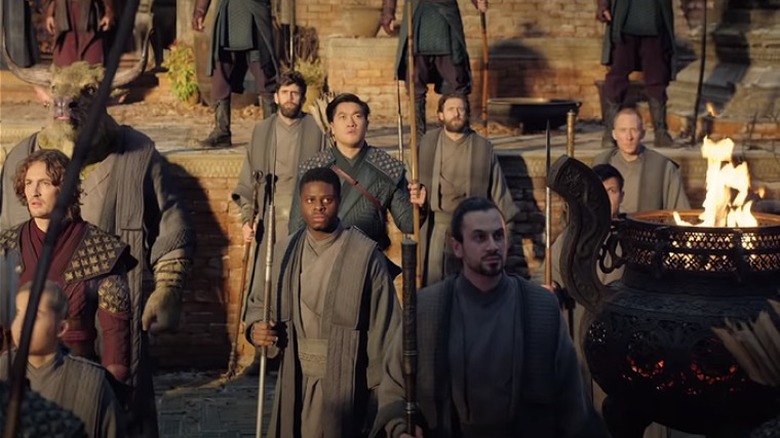
While Rintrah appeared pretty defenseless against Wanda's brutal attacks (to be fair, she annihilated Earth-838's Illuminati in a matter of minutes), he is an extremely gifted being with a range of abilities. Owing to his alien psychology, Rintrah has superhuman strength and endurance — the full extent of his strength was displayed when he punched a raging Hulk (!) in the comics. In terms of sorcery, Rintrah is an able sorcerer, with the ability to witness the "Strings of Fate" around living beings, which is a power alien to Strange.
Apart from this, Rintrah can also partake in dimensional travel, create force shields, and astral project, while also being able to shapeshift into humans (one of his favorite forms is Humphrey Bogart, and I'm legit sobbing at the cuteness). As per the comics, Rintrah eventually became an Adjunct Professor at the Strange Academy, teaching the foundational principles of algebra and geometry, which can be harnessed for mystical purposes.
Although Rintrah is not a focus in the film, which is understandable, as there is a LOT going on already, here's hoping that our green friend appears in more MCU projects, and maybe even fights beside Strange in the wars to come.
"Doctor Strange in the Multiverse of Madness" is currently playing in theaters.
Read this next: 11 Marvel Comics Villains We Really Want To See In The MCU
The post Who is Rintrah from Doctor Strange in the Multiverse of Madness? The Extradimensional Being Explained appeared first on /Film.




